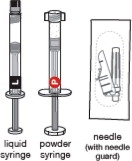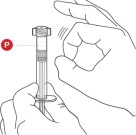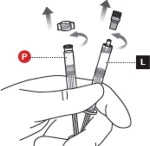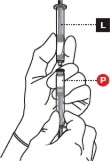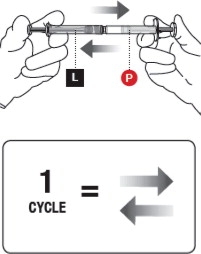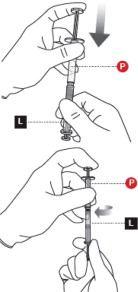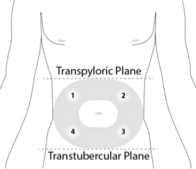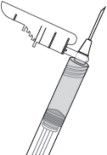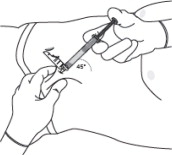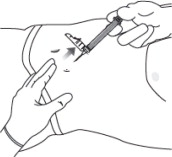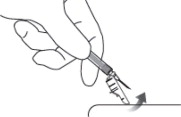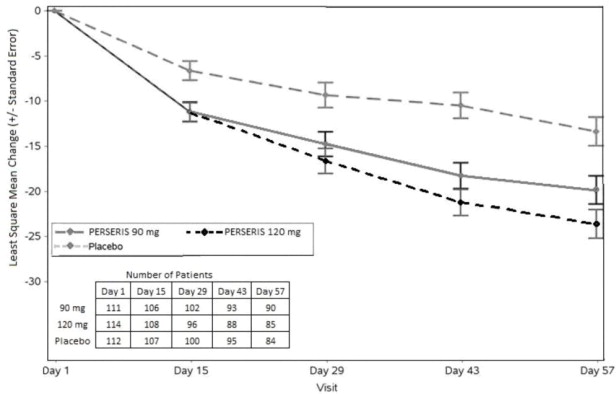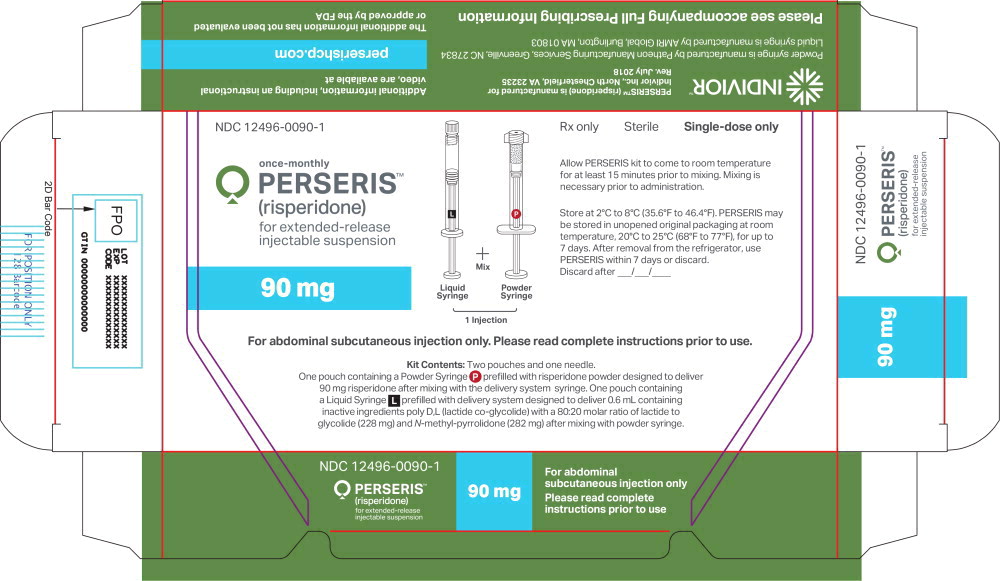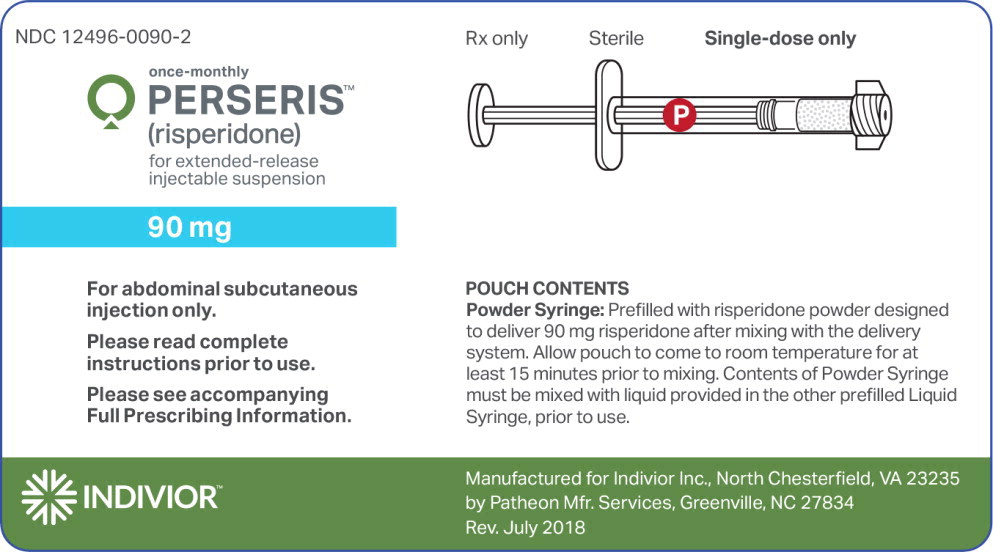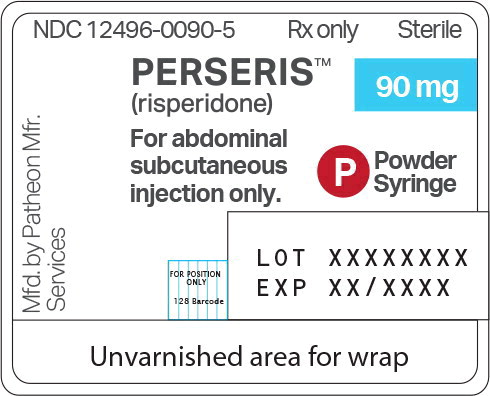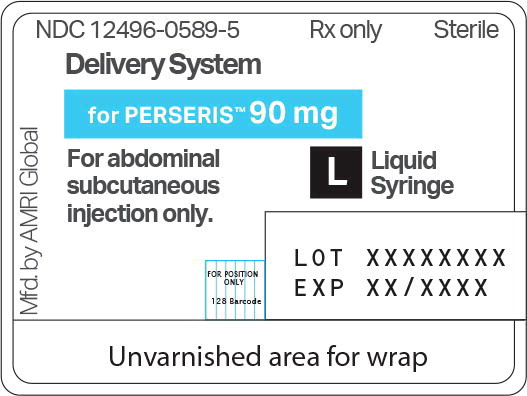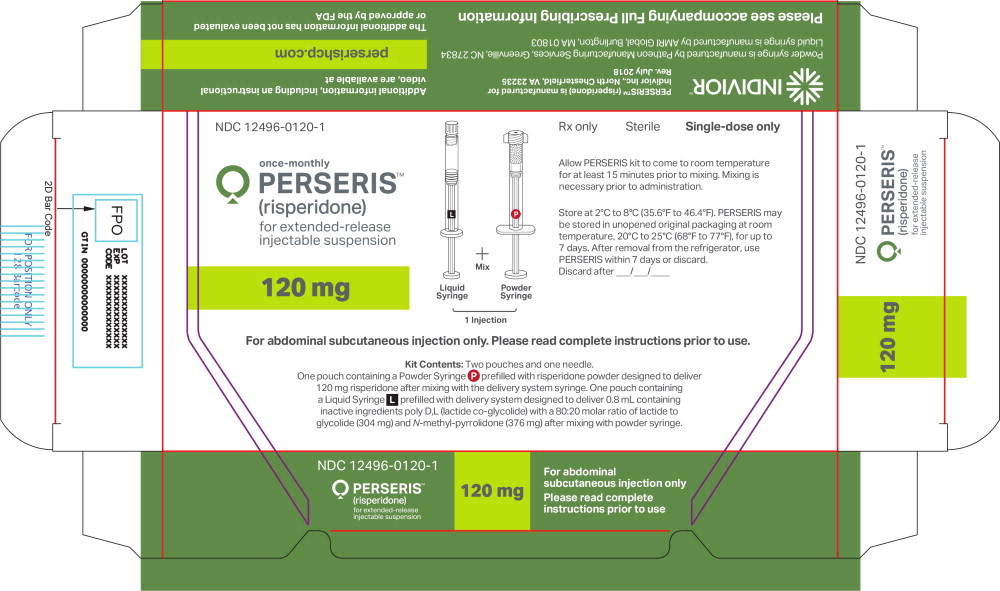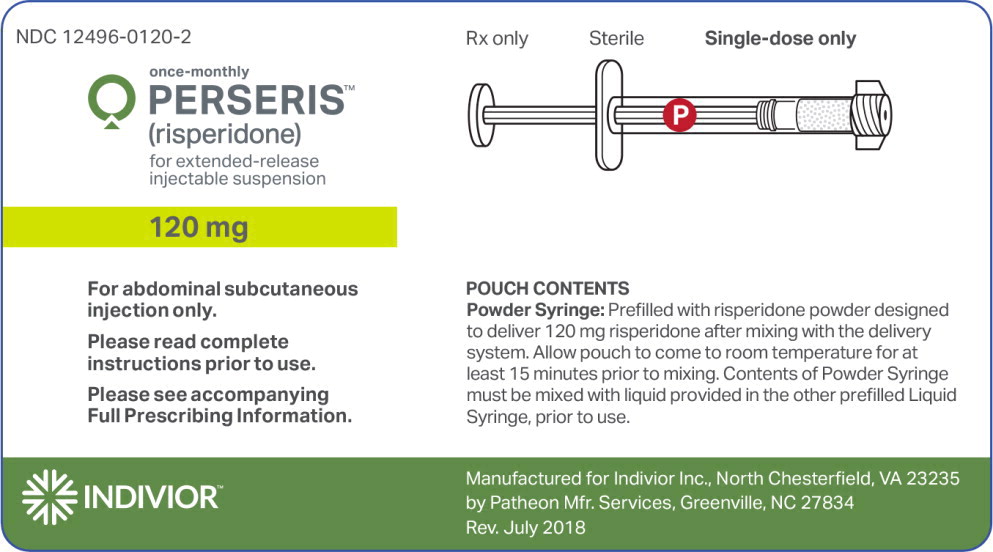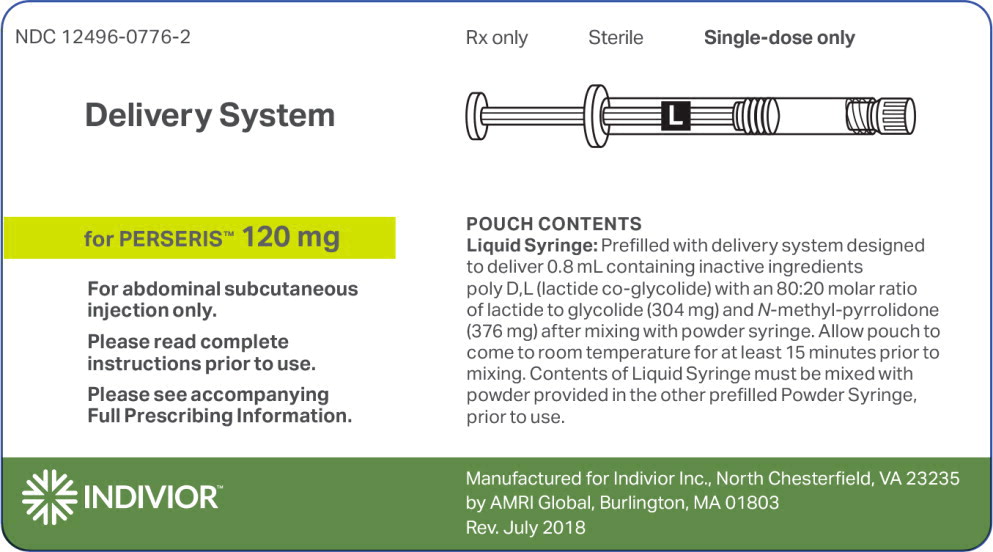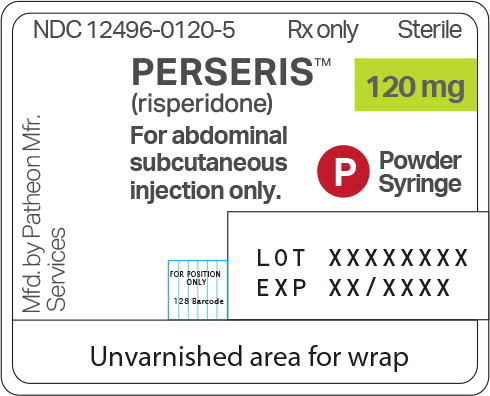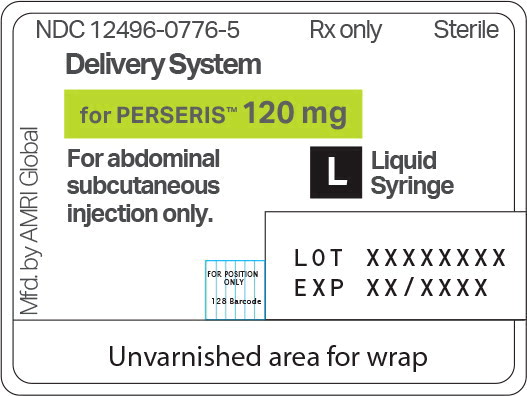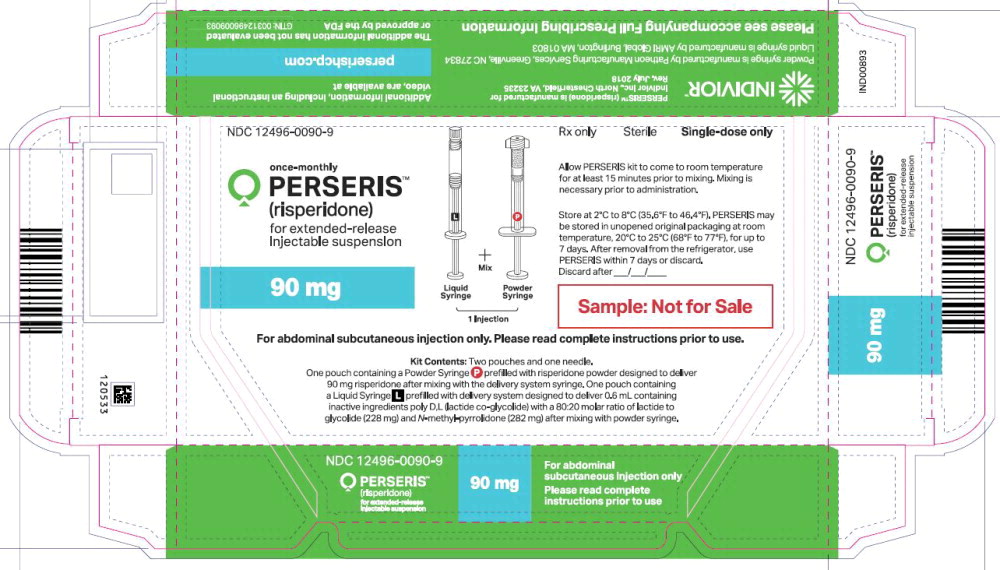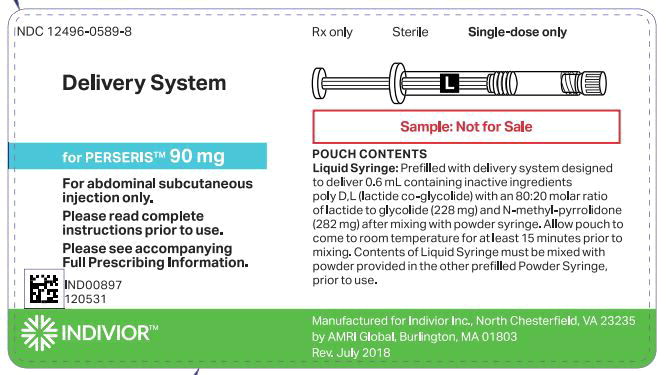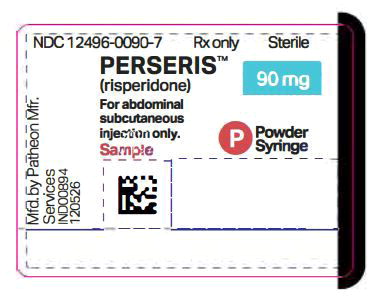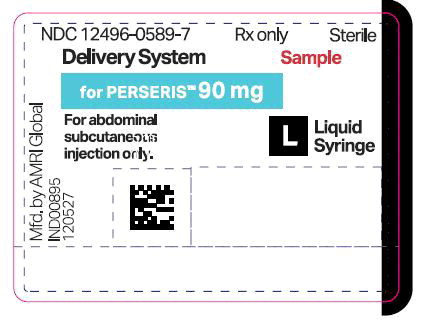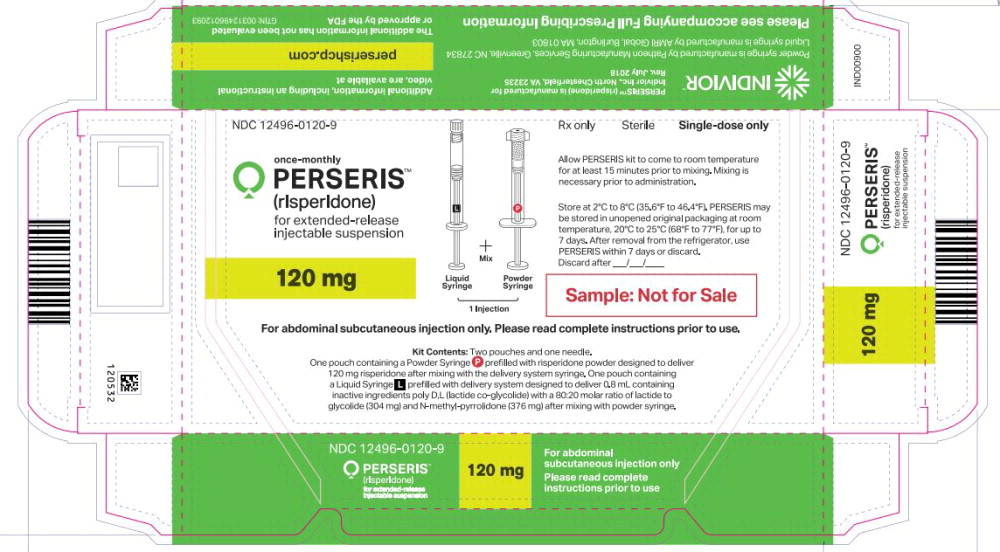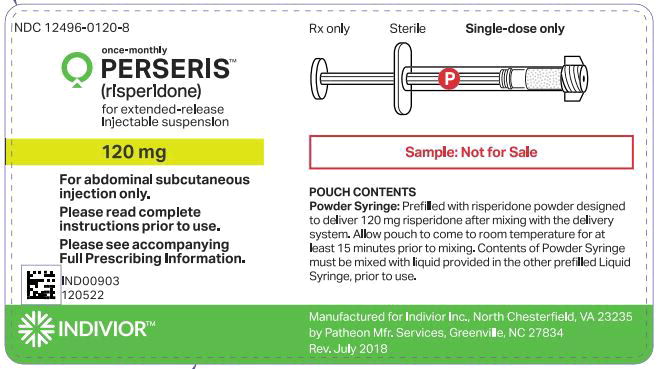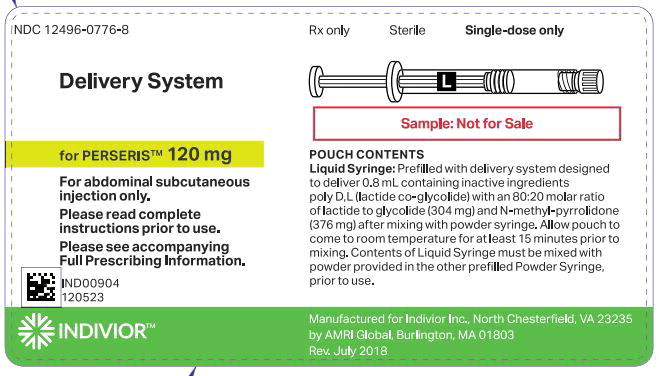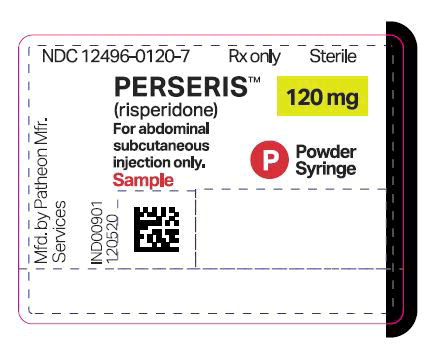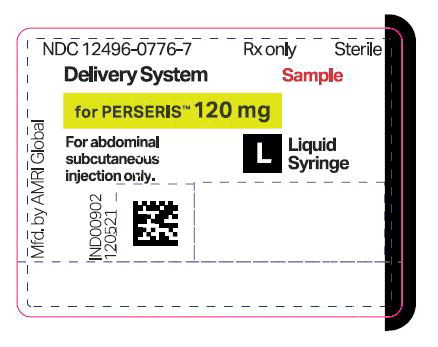PERSERIS- risperidone kit
PERSERIS by
Drug Labeling and Warnings
PERSERIS by is a Prescription medication manufactured, distributed, or labeled by Indivior Inc. , Curia Massachusetts, Inc., Curia Global, Inc., Assia Chemical Industries Ltd (Teva Tech site), Eurofins Lancaster Laboratories, Inc, Indivior Inc., Isomedix Operations Inc, Nelson Laboratories, LLC, Patheon Manufacturing Services LLC, SGS North America Inc, Sharp Packaging Services, LLC, Spectral Data Services, Inc., SYNERGY HEALTH AST, LLC, Teva API India Private Ltd.. Drug facts, warnings, and ingredients follow.
Drug Details [pdf]
-
HIGHLIGHTS OF PRESCRIBING INFORMATION
These highlights do not include all the information needed to use PERSERISTM safely and effectively. See full prescribing information for PERSERIS.
PERSERIS (risperidone) for extended-release injectable suspension, for subcutaneous use.
Initial U.S. Approval: 1993WARNING: INCREASED MORTALITY IN ELDERLY PATIENTS WITH DEMENTIA-RELATED PSYCHOSIS
See full prescribing information for complete boxed warning.
- Elderly patients with dementia-related psychosis treated with antipsychotic drugs are at an increased risk of death.
- PERSERISTM is not approved for use in patients with dementia-related psychosis. (5.1)
INDICATIONS AND USAGE
PERSERIS is an atypical antipsychotic indicated for the treatment of schizophrenia in adults. (1)
DOSAGE AND ADMINISTRATION
- Establish tolerability with oral risperidone. (2.1)
- PERSERIS may be initiated at a dose of 90 mg or 120 mg. (2.1)
- Supplementation with oral risperidone is not recommended. (2.1)
- Prior to use, the product is constituted by coupling the liquid and powder syringes and passing the contents back and forth between the syringes. (2.4)
- Failure to fully mix the medication could result in incorrect dosage. (2.4)
- Administer monthly by subcutaneous injection in the abdomen by a healthcare professional. Do not administer by any other route. (2.4)
- Do not administer more than one dose (90 mg or 120 mg total) per month. (2.1)
DOSAGE FORMS AND STRENGTHS
For extended-release injectable suspension: 90 mg and 120 mg risperidone. (3)
CONTRAINDICATIONS
Known hypersensitivity to risperidone, paliperidone, or other components of PERSERIS. (4)
WARNINGS AND PRECAUTIONS
- Cerebrovascular Adverse Reactions, Including Stroke in Elderly Patients with Dementia-Related Psychosis: Increased risk of cerebrovascular adverse reactions (e.g., stroke, transient ischemic attack), including fatalities. PERSERIS is not approved for use in patients with dementia-related psychosis. (5.2)
- Neuroleptic Malignant Syndrome (NMS): Manage with immediate discontinuation and close monitoring. (5.3)
- Tardive Dyskinesia: Discontinue treatment if clinically appropriate. (5.4)
- Metabolic Changes: Monitor for hyperglycemia, dyslipidemia, and weight gain. (5.5)
- Hyperprolactinemia: Prolactin elevations occur and persist during chronic administration. Long-standing hyperprolactinemia, when associated with hypogonadism, may lead to decreased bone density in females and males. (5.6)
- Orthostatic Hypotension: Monitor heart rate and blood pressure and warn patients with known cardiovascular disease or cerebrovascular disease, and risk of dehydration or syncope. (5.7)
- Leukopenia, Neutropenia, and Agranulocytosis: Perform complete blood counts (CBC) in patients with a history of a clinically significant low white blood cell count (WBC) or history of leukopenia or neutropenia. Consider discontinuing PERSERIS if a clinically significant decline in WBC occurs in absence of other causative factors. (5.9)
- Potential for Cognitive and Motor Impairment: Use caution when operating machinery. (5.10)
- Seizures: Use caution in patients with a history of seizures or with conditions that lower the seizure threshold. (5.11)
ADVERSE REACTIONS
The most common adverse reactions in clinical trials (≥ 5% and greater than twice placebo) were increased weight, sedation/somnolence, and musculoskeletal pain. (6)
To report SUSPECTED ADVERSE REACTIONS, contact Indivior Inc. at 1-877-782-6966 or FDA at 1-800-FDA-1088 or www.fda.gov/medwatch.
DRUG INTERACTIONS
USE IN SPECIFIC POPULATIONS
See 17 for PATIENT COUNSELING INFORMATION.
Revised: 12/2019
-
Table of Contents
FULL PRESCRIBING INFORMATION: CONTENTS*
WARNING: INCREASED MORTALITY IN ELDERLY PATIENTS WITH DEMENTIA- RELATED PSYCHOSIS
1 INDICATIONS AND USAGE
2 DOSAGE AND ADMINISTRATION
2.1 Recommended Dosage
2.2 Dosage Recommendations for Patients with Renal or Hepatic Impairment
2.3 Dosage Recommendations for Concomitant Use with Strong CYP2D6 Inhibitors and Strong CYP3A4 Inducers
2.4 Instructions for Use
3 DOSAGE FORMS AND STRENGTHS
4 CONTRAINDICATIONS
5 WARNINGS AND PRECAUTIONS
5.1 Increased Mortality in Elderly Patients with Dementia-Related Psychosis
5.2 Cerebrovascular Adverse Reactions, Including Stroke, in Elderly Patients with Dementia-Related Psychosis
5.3 Neuroleptic Malignant Syndrome (NMS)
5.4 Tardive Dyskinesia
5.5 Metabolic Changes
5.6 Hyperprolactinemia
5.7 Orthostatic Hypotension
5.8 Falls
5.9 Leukopenia, Neutropenia, and Agranulocytosis
5.10 Potential for Cognitive and Motor Impairment
5.11 Seizures
5.12 Dysphagia
5.13 Priapism
5.14 Body Temperature Regulation
6 ADVERSE REACTIONS
6.1 Clinical Trials Experience
6.2 Postmarketing Experience
7 DRUG INTERACTIONS
7.1 Drugs Having Clinically Important Interactions with PERSERIS
7.2 Drugs Having No Clinically Important Interactions with PERSERIS
8 USE IN SPECIFIC POPULATIONS
8.1 Pregnancy
8.2 Lactation
8.3 Females and Males of Reproductive Potential
8.4 Pediatric Use
8.5 Geriatric Use
8.6 Renal Impairment
8.7 Hepatic Impairment
10 OVERDOSAGE
10.1 Human Experience
10.2 Management of Overdosage
11 DESCRIPTION
12 CLINICAL PHARMACOLOGY
12.1 Mechanism of Action
12.2 Pharmacodynamics
12.3 Pharmacokinetics
13 NONCLINICAL TOXICOLOGY
13.1 Carcinogenesis, Mutagenesis, Impairment of Fertility
14 CLINICAL STUDIES
16 HOW SUPPLIED/STORAGE AND HANDLING
17 PATIENT COUNSELING INFORMATION
- * Sections or subsections omitted from the full prescribing information are not listed.
-
BOXED WARNING
(What is this?)
WARNING: INCREASED MORTALITY IN ELDERLY PATIENTS WITH DEMENTIA- RELATED PSYCHOSIS
Elderly patients with dementia-related psychosis treated with antipsychotic drugs are at an increased risk of death. PERSERISTM is not approved for the treatment of patients with dementia-related psychosis and has not been studied in this population [see Warnings and Precautions (5.1)].
- 1 INDICATIONS AND USAGE
-
2 DOSAGE AND ADMINISTRATION
2.1 Recommended Dosage
PERSERIS is to be administered as an abdominal subcutaneous injection only. Do not administer by any other route.
Each injection must be administered by a healthcare professional using the prepackaged injection syringe and enclosed safety needle [see Dosage and Administration (2.4)].
For patients who have never taken risperidone, establish tolerability with oral risperidone prior to starting PERSERIS.
Initiate PERSERIS at a dose of 90 mg or 120 mg once monthly by subcutaneous injection. Do not administer more than one dose (90 mg or 120 mg total) per month.
Based on average plasma concentrations (Cavg) of risperidone and total active moiety, PERSERIS 90 mg corresponds to 3 mg/day oral risperidone and PERSERIS 120 mg corresponds to 4 mg/day oral risperidone. Patients who are on stable oral risperidone doses lower than 3 mg/day or higher than 4 mg/day may not be candidates for PERSERIS [see Clinical Pharmacology (12.3) and Clinical Studies (14)].
Neither a loading dose nor any supplemental oral risperidone is recommended. A patient who misses a dose should receive the next dose as soon as possible.
2.2 Dosage Recommendations for Patients with Renal or Hepatic Impairment
PERSERIS has not been studied in patients with renal or hepatic impairment and should be used with caution in these special populations. Prior to initiating treatment with PERSERIS in these patients, it is advisable that patients be carefully titrated up to at least 3 mg daily of oral risperidone. If patients can tolerate 3 mg of oral risperidone and are psychiatrically stable, a dose of PERSERIS 90 mg may be considered [see Use in Specific Populations (8.6, 8.7) and Clinical Pharmacology (12.3)].
2.3 Dosage Recommendations for Concomitant Use with Strong CYP2D6 Inhibitors and Strong CYP3A4 Inducers
Co-administration with Strong CYP2D6 Inhibitors
When initiation of fluoxetine or paroxetine is considered, patients may be placed on the lowest dose (90 mg) of PERSERIS between 2- to 4-weeks before the planned start of fluoxetine or paroxetine therapy to adjust for the expected increase in plasma concentrations of risperidone.
When fluoxetine or paroxetine is initiated in patients receiving PERSERIS 90 mg, it is recommended to continue treatment with 90 mg unless clinical judgment necessitates interruption of PERSERIS treatment [see Drug Interactions (7.1)].
Co-administration with Strong CYP3A4 Inducers
At the initiation of therapy with carbamazepine or other known hepatic enzyme inducers, patients should be closely monitored during the first 4- to 8-weeks. In patients receiving PERSERIS 90 mg, consider increasing the dose to 120 mg. In patients receiving PERSERIS 120 mg, additional oral risperidone therapy may need to be considered.
On discontinuation of carbamazepine or other strong CYP3A4 hepatic enzyme inducers, the dosage of PERSERIS or any additional oral risperidone therapy should be re-evaluated and, if necessary, decreased to adjust for the expected increase in plasma concentration of risperidone.
For patients treated with PERSERIS 90 mg and discontinuing from carbamazepine or other strong CYP3A4 enzyme inducers, it is recommended to continue treatment with the 90 mg dose unless clinical judgment necessitates interruption of PERSERIS treatment [see Drug Interactions (7.1)].
2.4 Instructions for Use
Important Information
- For abdominal subcutaneous injection, only. Do not administer by any other route.
- To be administered by a healthcare professional only.
- Please read the instructions carefully before handling this product.
- Allow package to come to room temperature for at least 15 minutes prior to preparation.
- Only prepare medication when you are ready to administer the dose.
- As a universal precaution, always wear gloves.
1 CHECK CONTENTS
See Figure 1
-
One Liquid Syringe (
 ) prefilled with the delivery system. Inspect liquid solution for foreign particles. This is the syringe you will use to inject the patient.
) prefilled with the delivery system. Inspect liquid solution for foreign particles. This is the syringe you will use to inject the patient.
-
One Powder Syringe (
 ) prefilled with Risperidone powder. Inspect syringe for consistency of powder color and for foreign particles.
) prefilled with Risperidone powder. Inspect syringe for consistency of powder color and for foreign particles.
- One sterile 18-gauge, 5/8-inch safety needle.
Parenteral drug products should always be inspected visually for particulate matter and discoloration prior to administration, whenever solution and container permit.
2 TAP POWDER SYRINGE
See Figure 2
Hold the Powder Syringe upright and tap the barrel of the syringe to dislodge the packed powder.
NOTE: Powder can become packed during shipping.
3 UNCAP LIQUID AND POWDER SYRINGES
See Figure 3
Remove the cap from the Liquid Syringe, then remove the cap from the Powder Syringe.
Holding both syringes in your non-dominant hand can help with this step.
4 CONNECT THE SYRINGES
See Figure 4
Place the Liquid Syringe on top of the Powder Syringe (to prevent powder spillage) and connect the syringes by twisting approximately ¾ turn.
Do not over tighten.
Keep your fingers off the plungers during this step to avoid spillage of the medication.
5 MIX THE PRODUCT
See Figure 5
Failure to fully mix the medication could result in incorrect dosage.
Premixing
- Transfer the contents of the Liquid Syringe into the Powder Syringe.
- Gently push the Powder Syringe plunger until you feel resistance (to wet powder and avoid compacting).
- Repeat this gentle back-and-forth process for 5 cycles.
Complete mixing
- Continue mixing the syringes for an additional 55 cycles.
- This mixing can be more vigorous than when premixing.
- Figure 5 illustrates a correct full cycle.
When fully mixed, the product should be a cloudy suspension that is uniform in color. It can vary from white to yellow-green in color. If you see any clear areas in the mixture, continue to mix until the distribution of the color is uniform. The product is designed to deliver risperidone 90 mg or 120 mg.
6 PREPARE INJECTION SYRINGE
See Figure 6
Failure to aspirate the liquid from the Powder Syringe may result in incorrect dosage.
- First, transfer all contents into the Liquid Syringe.
- Next, perform the following actions SIMULTANEOUSLY:
- maintain slight pressure on the Powder Syringe plunger and
- pull back gently on the Liquid Syringe plunger while twisting the syringes apart.
- Finally, attach the safety needle by twisting until finger tight.
Check that medication is uniform in color and free from foreign particles.
7 PREPARE THE ABDOMINAL INJECTION SITE
See Figure 7
Choose an injection site on the abdomen with adequate subcutaneous tissue that is free of skin conditions (e.g., nodules, lesions, excessive pigment). It is recommended that the patient is in the supine position.
Do not inject into an area where the skin is irritated, reddened, bruised, infected or scarred in any way.
Clean the injection site well with an alcohol pad.
To help minimize irritation, rotate injection sites following a pattern similar to the illustration (Figure 7).
8 REMOVE EXCESS AIR FROM SYRINGE
See Figure 8
Hold the syringe upright for several seconds to allow air bubbles to rise.
Remove needle cover and slowly depress the plunger to push out the excess air from the syringe.
If medication is seen at the needle tip, pull back slightly on the plunger to prevent medication spillage.
Due to the viscous nature of the medication, bubbles will not rise as quickly as those in an aqueous solution.
9 PINCH INJECTION SITE
See Figure 9
Pinch the skin around the injection area. Be sure to pinch enough skin to accommodate the size of the needle. Lift the adipose tissue from the underlying muscle to prevent accidental intramuscular injection.
10 INJECT THE MEDICATION
See Figure 10
Insert needle fully into the subcutaneous tissue.
Inject the medication slow and steady.
PERSERIS is for subcutaneous administration only. Do not inject by any other route.
NOTE: Actual angle of injection will depend on the amount of subcutaneous tissue.
11 WITHDRAW NEEDLE
See Figure 11
Withdraw the needle at the same angle used for insertion and release pinched skin.
Do not rub the injection area after the injection. If there is bleeding, apply a gauze pad or bandage but use minimal pressure.
12 LOCK THE NEEDLE GUARD AND DISPOSE OF SYRINGE
See Figure 12
Lock the needle guard into place by pushing it against a hard surface such as a table.
Dispose of all syringe components in a secure sharps disposal container.
13 INSTRUCT THE PATIENT
See Figure 13
Advise the patient that they may have a lump for several weeks that will decrease in size over time. It is important that the patient not rub or massage the injection site and to be aware of the placement of any belts or clothing waistbands.
-
3 DOSAGE FORMS AND STRENGTHS
PERSERISTM (risperidone) for extended-release injectable suspension for subcutaneous use is available in strengths of 90 mg and 120 mg.
Each strength is provided as a kit which includes: one pre-filled syringe containing a white to yellow risperidone powder in a sealed pouch, one pre-filled syringe containing a colorless to yellow delivery system in a sealed pouch, and one 18-gauge, 5/8-inch needle.
- 4 CONTRAINDICATIONS
-
5 WARNINGS AND PRECAUTIONS
5.1 Increased Mortality in Elderly Patients with Dementia-Related Psychosis
Elderly patients with dementia-related psychosis treated with antipsychotic drugs are at an increased risk of death. Analyses of 17 placebo-controlled trials (modal duration of 10-weeks), largely in patients taking atypical antipsychotic drugs, revealed a risk of death in drug-treated patients between 1.6- to 1.7-times the risk of death in placebo-treated patients. Over the course of a typical 10-week controlled trial, the rate of death in drug-treated patients was about 4.5%, compared to a rate of about 2.6% in the placebo group. Although the causes of death were varied, most of the deaths appeared to be either cardiovascular (e.g., heart failure, sudden death) or infectious (e.g., pneumonia) in nature. Observational studies suggest that, similar to atypical antipsychotic drugs, treatment with conventional antipsychotic drugs may increase mortality. The extent to which the findings of increased mortality in observational studies may be attributed to the antipsychotic drug as opposed to some characteristic(s) of the patients is not clear.
PERSERIS is not approved for the treatment of patients with dementia-related psychosis.
5.2 Cerebrovascular Adverse Reactions, Including Stroke, in Elderly Patients with Dementia-Related Psychosis
Cerebrovascular adverse reactions (e.g., stroke, transient ischemic attack), including fatalities, were reported in patients (mean age 85-years; range 73 to 97) in trials of oral risperidone in elderly patients with dementia-related psychosis. In placebo-controlled trials, there was a significantly higher incidence of cerebrovascular adverse reactions in patients treated with oral risperidone compared to patients treated with placebo. PERSERIS is not approved for the treatment of patients with dementia-related psychosis.
5.3 Neuroleptic Malignant Syndrome (NMS)
A potentially fatal symptom complex sometimes referred to as NMS has been reported in association with antipsychotic drugs. Clinical manifestations of NMS are hyperpyrexia, muscle rigidity, altered mental status, and evidence of autonomic instability (irregular pulse or blood pressure, tachycardia, diaphoresis, and cardiac dysrhythmia). Additional signs may include elevated creatine phosphokinase, myoglobinuria (rhabdomyolysis), and acute renal failure.
The diagnostic evaluation of patients with this syndrome is complicated. In arriving at a diagnosis, it is important to identify cases in which the clinical presentation includes both serious medical illness (e.g., pneumonia, systemic infection, etc.) and untreated or inadequately treated extrapyramidal signs and symptoms (EPS). Other important considerations in the differential diagnosis include central anticholinergic toxicity, heat stroke, drug fever, and primary central nervous system pathology.
The management of NMS should include: (1) immediate discontinuation of antipsychotic drugs and other drugs not essential to concurrent therapy; (2) intensive symptomatic treatment and medical monitoring; and (3) treatment of any concomitant serious medical problems for which specific treatments are available. There is no general agreement about specific pharmacological treatment regimens for uncomplicated NMS.
If a patient requires antipsychotic drug treatment after recovery from NMS, reintroduction of drug therapy should be carefully considered. The patient should be carefully monitored, since recurrences of NMS have been reported.
5.4 Tardive Dyskinesia
A syndrome of potentially irreversible, involuntary, dyskinetic movements may develop in patients treated with antipsychotic drugs. Although the prevalence of the syndrome appears to be highest among the elderly, especially elderly women, it is impossible to rely upon prevalence estimates to predict, at the inception of antipsychotic treatment, which patients are likely to develop the syndrome. Whether antipsychotic drug products differ in their potential to cause tardive dyskinesia is unknown.
The risk of developing tardive dyskinesia and the likelihood that it will become irreversible are believed to increase as the duration of treatment and the total cumulative dose of antipsychotic drugs administered to the patient increase. However, the syndrome can develop, although much less commonly, after relatively brief treatment periods at low doses.
The syndrome may remit, partially or completely, if antipsychotic treatment is withdrawn. Antipsychotic treatment, itself, however, may suppress (or partially suppress) the signs and symptoms of the syndrome and thereby may possibly mask the underlying process. The effect that symptomatic suppression has upon the long-term course of the syndrome is unknown.
Given these considerations, PERSERIS should be prescribed in a manner that is most likely to minimize the occurrence of tardive dyskinesia. Chronic antipsychotic treatment should generally be reserved for patients who suffer from a chronic illness that: (1) is known to respond to antipsychotic drugs, and (2) for whom alternative, equally effective, but potentially less harmful treatments are not available or appropriate. In patients who do require chronic treatment, the smallest dose and the shortest duration of treatment producing a satisfactory clinical response should be sought. The need for continued treatment should be reassessed periodically.
If signs and symptoms of tardive dyskinesia appear in a patient treated with PERSERIS, drug discontinuation should be considered. However, some patients may require treatment with PERSERIS despite the presence of the syndrome.
5.5 Metabolic Changes
Atypical antipsychotic drugs have been associated with metabolic changes that may increase cardiovascular/cerebrovascular risk. These metabolic changes include hyperglycemia, dyslipidemia, and body weight gain. While all of the drugs in the class have been shown to produce some metabolic changes, each drug has its own specific risk profile.
Hyperglycemia and Diabetes Mellitus
Hyperglycemia and diabetes mellitus, in some cases extreme and associated with ketoacidosis or hyperosmolar coma or death, have been reported in patients treated with atypical antipsychotics including risperidone. Assessment of the relationship between atypical antipsychotic use and glucose abnormalities is complicated by the possibility of an increased background risk of diabetes mellitus in patients with schizophrenia and the increasing incidence of diabetes mellitus in the general population. Given these confounders, the relationship between atypical antipsychotic use and hyperglycemia-related adverse events is not completely understood. However, epidemiological studies suggest an increased risk of treatment-emergent hyperglycemia-related adverse events in patients treated with the atypical antipsychotics. Precise risk estimates for hyperglycemia-related adverse events in patients treated with atypical antipsychotics are not available.
Patients with an established diagnosis of diabetes mellitus who are started on atypical antipsychotics, including PERSERIS, should be monitored regularly for worsening of glucose control. Patients with risk factors for diabetes mellitus (e.g., obesity, family history of diabetes) who are starting treatment with atypical antipsychotics, including PERSERIS, should undergo fasting blood glucose testing at the beginning of treatment and periodically during treatment. Any patient treated with atypical antipsychotics, including PERSERIS, should be monitored for symptoms of hyperglycemia including polydipsia, polyuria, polyphagia, and weakness. Patients who develop symptoms of hyperglycemia during treatment with atypical antipsychotics, including PERSERIS, should undergo fasting blood glucose testing. In some cases, hyperglycemia has resolved when the atypical antipsychotic, including risperidone, was discontinued; however, some patients required continuation of anti-diabetic treatment despite discontinuation of risperidone.
Data from an 8-week double-blind, placebo-controlled study with PERSERIS in adult subjects with schizophrenia are presented in Table 1.
Table 1. Changes in Fasting Glucose from Baseline to End of Study (EOS) and Postbaseline Abnormal Values of Glucose > 126 mg/dL in an 8-Week Double-Blind, Placebo-Controlled Study in Adult Subjects with Schizophrenia † The “n”s in the Serum Glucose mean row are the number of subjects with data at baseline and EOS visits.
‡ Data shown as number of subjects with at least one postbaseline value as denominator and number of subjects satisfying the predefined criterion as numerator.
PERSERIS
90 mgPERSERIS
120 mgPlacebo n = 98 n = 106 n = 96 Serum Glucose, mg/dL, mean † Mean Change from Baseline to EOS 5.7 6.3 -0.9 Glucose, > 126 mg/dL Proportion of Subjects with Postbaseline Abnormal Values‡ 12/104 (11.5%) 14/111 (12.6%) 8/109 (7.3%) Similar changes from baseline in serum glucose were observed in subjects receiving PERSERIS during an open-label, 12-month long-term safety study. Additionally, the mean HbA1c increased from 5.6 to 5.7% over the 12-months.
Dyslipidemia
Undesirable alterations in lipids have been observed in patients treated with atypical antipsychotics.
Data from an 8-week double-blind, placebo-controlled study with PERSERIS in adult subjects with schizophrenia are presented in Table 2.
Table 2. Changes in Cholesterol from Baseline to End of Study (EOS) and Postbaseline Abnormal Values of Cholesterol ≥ 300 mg/dL in an 8-Week Double-Blind, Placebo-Controlled Study in Adult Subjects with Schizophrenia † The “n”s in the Cholesterol mean row are the number of subjects with data at baseline and EOS visits.
‡ Data shown as number of subjects with at least one postbaseline value as denominator and number of subjects satisfying the predefined criterion as numerator.
PERSERIS
90 mgPERSERIS
120 mgPlacebo Cholesterol, mg/dL, mean † n = 98 n = 106 n = 96 Mean Change from Baseline to EOS -0.5 -0.5 1.1 Cholesterol, ≥ 300 mg/dL Proportion of Subjects with Postbaseline Abnormal Values‡ 2/104 (1.9%) 2/111 (1.8%) 2/109 (1.8%) Weight Gain
Weight gain has been observed with atypical antipsychotic use. Clinical monitoring of weight is recommended.
Data from an 8-week double-blind, placebo-controlled study with PERSERIS in adult subjects with schizophrenia are presented in Table 3.
Table 3. Changes in Body Weight from Baseline to End of Study (EOS) and ≥ 7% Increase from Baseline in an 8-Week Double-Blind, Placebo-Controlled Study in Adult Subjects with Schizophrenia † The “n”s in the Weight Change mean row are the number of subjects with data at baseline and end of study visits.
‡ Data shown as number of subjects with at least one postbaseline value as denominator and number of subjects satisfying the predefined criterion as numerator.
PERSERIS
90 mgPERSERIS
120 mgPlacebo Weight † n = 105 n = 112 n = 107 Mean Change from Baseline to EOS, kg 4.4 5.3 2.6 Weight Gain ≥ 7% Increase from Baseline‡ 35/107 (32.7%) 48/114 (42.1%) 20/111 (18.0%) In an open-label, 12-month long-term safety study, for all subjects receiving PERSERIS, mean weight increased approximately 2 kg from baseline to Day 85, then remained stable for the remainder of the study.
5.6 Hyperprolactinemia
As with other drugs that antagonize dopamine D2 receptors, risperidone elevates prolactin levels and the elevation persists during chronic administration. Risperidone is associated with higher levels of prolactin elevation than other antipsychotic agents.
Hyperprolactinemia may suppress hypothalamic GnRH, resulting in reduced pituitary gonadotropin secretion. This, in turn, may inhibit reproductive function by impairing gonadal steroidogenesis in both female and male patients. Galactorrhea, amenorrhea, gynecomastia, and impotence have been reported in patients receiving prolactin-elevating compounds. Long-standing hyperprolactinemia when associated with hypogonadism may lead to decreased bone density in both female and male subjects.
Tissue culture experiments indicate that approximately one-third of human breast cancers are prolactin dependent in vitro, a factor of potential importance if the prescription of these drugs is contemplated in a patient with previously detected breast cancer. An increase in pituitary gland, mammary gland, and pancreatic islet cell neoplasia (mammary adenocarcinomas, pituitary and pancreatic adenomas) was observed in the risperidone carcinogenicity studies conducted in mice and rats [see Nonclinical Toxicology (13.1)]. Neither clinical studies nor epidemiologic studies conducted to date have shown an association between chronic administration of this class of drugs and tumorigenesis in humans; the available evidence is considered too limited to be conclusive at this time.
5.7 Orthostatic Hypotension
Risperidone may induce orthostatic hypotension associated with dizziness, tachycardia, and in some patients, syncope, probably reflecting its alpha-adrenergic antagonistic properties.
PERSERIS should be used with particular caution in (1) patients with known cardiovascular disease (history of myocardial infarction or ischemia, heart failure, or conduction abnormalities), cerebrovascular disease, and conditions which would predispose patients to hypotension, e.g., dehydration and hypovolemia, and (2) in the elderly and patients with renal or hepatic impairment. Monitoring of orthostatic vital signs should be considered in all such patients, and a dose reduction should be considered if hypotension occurs. Clinically significant hypotension has been observed with concomitant use of oral risperidone and antihypertensive medication.
5.8 Falls
Somnolence, postural hypotension, motor instability, and sensory instability have been reported with the use of antipsychotics, including PERSERIS, which may lead to falls and, consequently, fractures or other fall-related injuries. For patients, particularly the elderly, with diseases, conditions, or medications that could exacerbate these effects, assess the risk of falls when initiating antipsychotic treatment and recurrently for patients on long-term antipsychotic therapy.
5.9 Leukopenia, Neutropenia, and Agranulocytosis
In clinical trial and/or postmarketing experience, events of leukopenia/neutropenia have been reported temporally related to antipsychotic agents, including risperidone. Agranulocytosis has also been reported.
Possible risk factors for leukopenia/neutropenia include pre-existing low white blood cell count (WBC) and a history of drug-induced leukopenia/neutropenia. Patients with a history of a clinically significant low WBC or a drug-induced leukopenia/neutropenia should have their complete blood count (CBC) monitored frequently during the first few months of therapy and discontinuation of PERSERIS should be considered at the first sign of a clinically significant decline in WBC in the absence of other causative factors.
Patients with clinically significant neutropenia should be carefully monitored for fever or other symptoms or signs of infection and treated promptly if such symptoms or signs occur. Patients with severe neutropenia (absolute neutrophil count < 1000/mm3) should discontinue PERSERIS and have their WBC followed until recovery.
5.10 Potential for Cognitive and Motor Impairment
In an 8-week, double-blind, placebo-controlled study, somnolence/sedation was reported by 7.0% and 7.7% of subjects treated with PERSERIS 90 mg and 120 mg, respectively.
Since risperidone has the potential to impair judgment, thinking, or motor skills, patients should be cautioned about operating hazardous machinery, including automobiles, until they are reasonably certain that treatment with PERSERIS does not affect them adversely.
5.11 Seizures
Seizures have been observed during pre-marketing studies of risperidone in adult patients with schizophrenia. PERSERIS should be used cautiously in patients with a history of seizures or other conditions that potentially lower the seizure threshold.
5.12 Dysphagia
Esophageal dysmotility and aspiration have been associated with antipsychotic drug use. Aspiration pneumonia is a common cause of morbidity and mortality in patients with advanced Alzheimer's dementia. PERSERIS and other antipsychotic drugs should be used cautiously in patients at risk for aspiration pneumonia [see Boxed Warning and Warnings and Precautions (5.1)].
5.13 Priapism
Priapism has been reported during postmarketing surveillance for other risperidone products. Severe priapism may require surgical intervention.
5.14 Body Temperature Regulation
Disruption of body temperature regulation has been attributed to antipsychotic agents. Both hyperthermia and hypothermia have been reported in association with oral risperidone use. Caution is advised when prescribing PERSERIS for patients who will be exposed to temperature extremes.
-
6 ADVERSE REACTIONS
The following are discussed in more detail in previous sections of the labeling:
- Increased Mortality in Elderly Patients with Dementia-Related Psychosis [see Boxed Warning and Warnings and Precautions (5.1)]
- Cerebrovascular Adverse Reactions, Including Stroke, in Elderly Patients with Dementia-Related Psychosis [see Warnings and Precautions (5.2)]
- Neuroleptic Malignant Syndrome (NMS) [see Warnings and Precautions (5.3)]
- Tardive Dyskinesia [see Warnings and Precautions (5.4)]
- Metabolic Changes [see Warnings and Precautions (5.5)]
- Hyperprolactinemia [see Warnings and Precautions (5.6)]
- Orthostatic Hypotension [see Warnings and Precautions (5.7)]
- Falls [see Warnings and Precautions (5.8)]
- Leukopenia, Neutropenia and Agranulocytosis [see Warnings and Precautions (5.9)]
- Potential for Cognitive and Motor Impairment [see Warnings and Precautions (5.10)]
- Seizures [see Warnings and Precautions (5.11)]
- Dysphagia [see Warnings and Precautions (5.12)]
- Priapism [see Warnings and Precautions (5.13)]
- Body Temperature Regulation [see Warnings and Precautions (5.14)]
6.1 Clinical Trials Experience
Because clinical trials are conducted under widely varying conditions, adverse reaction rates observed in the clinical trials of a drug cannot be directly compared to rates in the clinical trials of another drug and may not reflect the rates observed in practice.
The safety of PERSERIS was evaluated in a total of 814 adult subjects with schizophrenia who received at least 1 dose of PERSERIS during the clinical development program. A total of 322 subjects were exposed to PERSERIS for at least 6-months, of which 234 subjects were exposed to PERSERIS for at least 12-months; 281 and 176 of these, respectively, received the 120 mg dose.
Adverse drug reactions in adult subjects with schizophrenia (≥ 5% in any PERSERIS-treated group and greater than placebo) during the 8-week double-blind, placebo-controlled study) were weight increased, constipation, sedation/somnolence, pain in extremity, back pain, akathisia, anxiety, and musculoskeletal pain. In addition, the frequency of reported injection site reactions was similar across treatment groups with both PERSERIS and placebo; the most common (≥ 5%) of which were injection site pain, and erythema. The systemic safety profile for PERSERIS, was consistent with the known safety profile of oral risperidone.
Commonly-Observed Adverse Drug Reactions in Double-Blind, Placebo-Controlled Clinical Studies – Schizophrenia
Adverse Reactions with an incidence of 2% or more and greater than placebo are shown in Table 4.
Table 4. Adverse Drug Reactions in 2% or More of PERSERIS-Treated Subjects (and Greater than Placebo) in an 8-Week Double-Blind, Placebo-Controlled Study * Sedation includes sedation and somnolence
System Organ Class
Preferred TermPERSERIS
90 mg
(n = 115)PERSERIS
120 mg
(n = 117)Placebo
(n = 118)Percentage of Subjects Reporting ADR Gastrointestinal disorders Constipation 7.0 7.7 5.1 Abdominal discomfort 2.6 2.6 1.7 Dry mouth 1.7 2.6 1.7 Investigations Weight increased 13.0 12.8 3.4 Metabolism and nutrition disorders Increased appetite 1.7 3.4 1.7 Musculoskeletal and connective tissue disorders Back pain 3.5 6.8 4.2 Pain in extremity 0.9 7.7 5.1 Musculoskeletal pain 5.2 5.1 2.5 Musculoskeletal stiffness 2.6 0.9 1.7 Muscle spasms 0 2.6 0 Nervous system disorders Sedation* 7.0 7.7 0 Akathisia 2.6 6.8 4.2 Extrapyramidal disorder 4.3 1.7 0.8 Psychiatric disorders Anxiety 2.6 6.8 5.1 Other Adverse Drug Reactions Observed During the Clinical Trial Evaluation of PERSERIS
The following list does not include reactions: 1) already listed in previous tables or elsewhere in labeling, 2) which are part of the disease state, 3) for which a drug cause was remote, 4) which were so general as to be uninformative, or 5) which were not considered to have significant clinical implications.
Blood and Lymphatic System Disorders: neutropenia
Ear and Labyrinth Disorders: vertigo
Endocrine Disorders: hyperprolactinemia
Eye Disorders: blepharospasm
Gastrointestinal Disorders: nausea, dyspepsia, vomiting, diarrhea, abdominal pain upper, salivary hypersecretion, hypoesthesia oral, tongue movement disturbance
General Disorders and Administration Site Conditions: injection site reaction (including injection site pain, induration, pruritus, bruising, erythema, inflammation, swelling and irritation) fatigue, edema peripheral, asthenia, chest discomfort
Investigations: blood prolactin increased, blood glucose increased, glycosylated hemoglobin increased, electrocardiogram abnormal, electrocardiogram QT prolonged, blood creatine phosphokinase increased
Metabolism and Nutrition Disorders: diabetes mellitus, decreased appetite
Musculoskeletal, Connective Tissue, and Bone Disorders: arthralgia, muscle twitching, joint stiffness, trismus
Nervous System Disorders: headache, dizziness, tremor, drooling, dyskinesia, lethargy, dystonia, hypoesthesia, oromandibular dystonia, tardive dyskinesia, cogwheel rigidity, dysarthria, balance disorder, parkinsonian rest tremor, parkinsonism, slow speech
Psychiatric Disorders: insomnia, libido decreased, bruxism, restlessness, anorgasmia, loss of libido
Reproductive System and Breast Disorders: erectile dysfunction, galactorrhea, breast tenderness, breast pain, amenorrhea, breast engorgement, ejaculation delayed, ejaculation disorder, gynecomastia, hypomenorrhea, breast discharge, breast enlargement, ejaculation failure, menstruation delayed, menstruation irregular, polymenorrhea
Skin and Subcutaneous Tissue Disorders: night sweats
Vascular Disorders: hypertension, hypotension, orthostatic hypotension
Other Adverse Reactions Observed During the Clinical Trial Evaluations of Oral Risperidone
The following is a list of additional ADRs that have been reported during the clinical trial evaluation of oral risperidone, regardless of frequency of occurrence:
Blood and Lymphatic System Disorders: anemia, granulocytopenia
Cardiac Disorders: tachycardia, sinus bradycardia, sinus tachycardia, atrioventricular block first degree, bundle branch block left, bundle branch block right, atrioventricular block
Ear and Labyrinth Disorders: ear pain, tinnitus
Eye Disorders: vision blurred, oculogyration, ocular hyperemia, eye discharge, conjunctivitis, eye rolling, eyelid edema, eye swelling, eyelid margin crusting, dry eye, lacrimation increased, photophobia, glaucoma, visual acuity reduced
Gastrointestinal Disorders: dysphagia, fecaloma, fecal incontinence, gastritis, lip swelling, cheilitis, aptyalism
General Disorders: thirst, gait disturbance, chest pain, influenza-like illness, pitting edema, edema, chills, sluggishness, malaise, face edema, discomfort, generalized edema, drug withdrawal syndrome, peripheral coldness, feeling abnormal
Immune System Disorders: drug hypersensitivity
Infections and Infestations: nasopharyngitis, upper respiratory tract infection, sinusitis, urinary tract infection, pneumonia, influenza, ear infection, viral infection, pharyngitis, tonsillitis, bronchitis, eye infection, localized infection, cystitis, cellulitis, otitis media, onychomycosis, acarodermatitis, bronchopneumonia, respiratory tract infection, tracheobronchitis, otitis media chronic
Investigations: body temperature increased, alanine aminotransferase increased, heart rate increased, eosinophil count increased, white blood cell count decreased, hemoglobin decreased, blood creatine phosphokinase increased, hematocrit decreased, body temperature decreased, blood pressure decreased, transaminases increased
Metabolism and Nutrition Disorders: polydipsia, anorexia
Musculoskeletal, Connective Tissue, and Bone Disorders: joint swelling, musculoskeletal chest pain, posture abnormal, myalgia, neck pain, muscular weakness, muscle rigidity, muscle contracture, rhabdomyolysis
Nervous System Disorders: dizziness postural, disturbance in attention, unresponsive to stimuli, depressed level of consciousness, movement disorder, hypokinesia, bradykinesia, transient ischemic attack, coordination abnormal, cerebrovascular accident, masked facies, speech disorder, syncope, loss of consciousness, muscle contractions involuntary, Parkinson's disease, tongue paralysis, akinesia, cerebral ischemia, cerebrovascular disorder, neuroleptic malignant syndrome, diabetic coma, head titubation
Psychiatric Disorders: agitation, blunted affect, confusional state, middle insomnia, nervousness, sleep disorder, listlessness
Renal and Urinary Disorders: enuresis, dysuria, pollakiuria, urinary incontinence
Reproductive System and Breast Disorders: vaginal discharge, menstrual disorder, retrograde ejaculation, sexual dysfunction
Respiratory, Thoracic, and Mediastinal Disorders: nasal congestion, dyspnea, epistaxis, wheezing, pneumonia aspiration, sinus congestion, dysphonia, productive cough, pulmonary congestion, respiratory tract congestion, rales, respiratory disorder, hyperventilation, nasal edema
Skin and Subcutaneous Tissue Disorders: rash, dry skin, erythema, skin discoloration, skin lesion, pruritus, skin disorder, rash erythematous, rash papular, acne, hyperkeratosis, seborrheic dermatitis, rash generalized, rash maculopapular
Vascular Disorders: flushing
Discontinuations Due to Adverse Drug Reactions (ADRs)
There was no single adverse reaction leading to discontinuation that occurred at a rate of ≥ 2% in PERSERIS-treated patients and greater than placebo.
Dose Dependency of Adverse Drug Reactions in Clinical Trials
Changes in Body Weight
Data from the double-blind placebo-controlled study indicated there was a dose-dependent increase in mean changes in weight from baseline to postdose assessments in the PERSERIS 90 mg and 120 mg groups compared with the placebo group [see Warnings and Precautions (5.5), Adverse Reactions (6.1, Table 4)].
Increased Prolactin
In the 8-week double-blind, placebo-controlled study, there was a typical increase in mean prolactin levels in fasting blood samples from baseline to the EOS assessments in both the PERSERIS 90 mg and 120 mg groups, while mean prolactin for the placebo group remained stable during the study. Changes in mean prolactin were dose-dependent and more pronounced in female subjects than male subjects.
Extrapyramidal Symptoms (EPS)
Several methods were used to measure EPS, including: (1) the Barnes Akathisia Rating Scale (BARS) global clinical rating score which evaluates akathisia, (2) the Abnormal Involuntary Movement Scale (AIMS) scores which evaluates dyskinesia, (3) the Simpson-Angus Scale (SAS) global score which broadly evaluates parkinsonism, and (4) the incidence of spontaneous reports of EPS-related adverse reactions.
In the 8-week double-blind, placebo-controlled study, the mean changes from baseline in BARS, AIMS, and SAS total scores were comparable between PERSERIS- and placebo-treated patients. At all postbaseline assessments, mean changes from baseline were between -0.1 and 0.2 (inclusive) for the BARS, between 0 and 0.2 (inclusive) for the AIMS and between -0.1 and 0.2 (inclusive) for the SAS.
The rates of ADRs associated with EPS were similar across treatment groups, including placebo. There was a higher incidence of akathisia in the PERSERIS 120 mg (6.8%) group compared with the PERSERIS 90 mg (2.6%) and placebo group (4.2%); reports of extrapyramidal disorders were higher in the PERSERIS 90 mg group (4.3%) compared with the PERSERIS 120 mg (1.7%) and placebo group (0.8%). In contrast, there was a higher incidence of dystonia in the placebo group (2.5%) compared with the PERSERIS groups (0 and 0.9%, respectively).
Dystonia
Symptoms of dystonia, prolonged abnormal contractions of muscle groups, may occur in susceptible individuals during the first few days of treatment. Dystonic symptoms include: spasm of the neck muscles, sometimes progressing to tightness of the throat, swallowing difficulty, difficulty breathing, and/or protrusion of the tongue. Although these symptoms can occur at low doses, they occur more frequently and with greater severity with high potency and at higher doses of first generation antipsychotic drugs. An elevated risk of acute dystonia has been observed in males and younger age groups.
Changes in ECG
In the 8-week double-blind, placebo-controlled study, there were no clinically relevant differences in mean changes from baseline to EOS in ECG parameters, including QTcF (Fridericia's corrected QT interval), QRS and PR intervals, and heart rate, in subjects in either PERSERIS treatment group (90 mg and 120 mg) compared with placebo. Similarly, in the 12-month, long-term safety study, there were no clinically relevant changes in mean ECG interval values from baseline to postdose assessments.
Pain Assessment and Local Injection Site Reactions
Local injection site pain was assessed using subject-reported VAS scales (0 = no pain to 100 = unbearably painful). In the 8-week, double-blind placebo-controlled study, the mean subject-reported injection site pain VAS scores were similar for all treatment groups following both injections. Pain scores decreased from a mean of 27 (VAS score) 1 minute after the first dose to a range of 3 to 7 (VAS score) 30 to 60 minutes postdose. In the 12-month, long-term safety study, the 1-minute postdose injection site pain VAS scores were highest on Day 1 (mean of 25) and decreased over time with subsequent injections (14 to 16 following last injection).
The local injection site was assessed by appropriately trained personnel. Throughout the clinical development program, the maximum reported intensity at any time point for each injection site assessment (pain, tenderness, inflammation/swelling and erythema) was none or mild for most subjects receiving PERSERIS.
Most subjects (≥ 79%) reported no tenderness and most who had tenderness reported mild severity. Less than 1% of subjects had moderate tenderness at any time point and 1 subject at Injections 1, 2, and 5 had severe tenderness. At each time point, most subjects (≥ 75%) reported no pain on injection. Of subjects who did have pain on injection, almost all of these were mild at each time point; only 1 or 2 subjects at Injections 1, 2, 7, and 12 had moderate pain on injection. At least 92% of subjects reported no erythema on each injection. All reports of erythema were of mild severity except for 2 cases of moderate erythema on Injection 1. Inflammation/swelling had a similar profile, with at least 88% of subjects reporting no inflammation/swelling and only mild symptoms except for 1 case of moderate severity on Injection 1.
6.2 Postmarketing Experience
The following adverse reactions have been identified during post approval use of oral risperidone. Because these reactions are reported voluntarily from a population of uncertain size, it is not always possible to reliably estimate their frequency or establish a causal relationship to drug exposure. These adverse reactions include: alopecia, anaphylactic reaction, angioedema, atrial fibrillation, cardiopulmonary arrest, diabetic ketoacidosis in patients with impaired glucose metabolism, dysgeusia, hypoglycemia, hypothermia, ileus, inappropriate antidiuretic hormone secretion, intestinal obstruction, jaundice, mania, pancreatitis, pituitary adenoma, precocious puberty, pulmonary embolism, QT prolongation, sleep apnea syndrome, sudden death, thrombocytopenia, thrombotic thrombocytopenic purpura, urinary retention, water intoxication, and Stevens-Johnson syndrome and toxic epidermal necrolysis (SJS/TEN).
-
7 DRUG INTERACTIONS
The interactions of PERSERIS with co-administration of other drugs have not been studied. The drug interaction data provided in this section is based on studies with oral risperidone.
7.1 Drugs Having Clinically Important Interactions with PERSERIS
Table 5 includes clinically significant drug interactions with PERSERIS.
Table 5: Clinically Important Drug Interactions with PERSERIS Strong CYP2D6 Inhibitors Clinical Impact: Concomitant use of PERSERIS with strong CYP2D6 inhibitors may increase the plasma exposure of risperidone and lower the plasma exposure of a major active metabolite, 9-hydroxyrisperidone [see Clinical Pharmacology (12.3)]. Intervention: When initiation of strong CYP2D6 inhibitors is considered, patients may be placed on the lowest dose (90 mg) of PERSERIS between 2- to 4-weeks before the planned start of strong CYP2D6 inhibitors to adjust for the expected increase in plasma concentrations of risperidone. When strong CYP2D6 inhibitors is initiated in patients receiving PERSERIS 90 mg, it is recommended to continue treatment with 90 mg unless clinical judgment necessitates interruption of PERSERIS treatment. The effects of discontinuation of strong CYP2D6 inhibitors on the pharmacokinetics of risperidone and 9-hydroxyrisperidone have not been studied [see Clinical Pharmacology (12.3)]. Examples: paroxetine, fluoxetine, quinidine Strong CYP3A4 Inducers Clinical Impact: Concomitant use of PERSERIS and a strong CYP3A4 inducer may cause decreases in the combined plasma concentrations of risperidone and 9-hydroxyrisperidone which could lead to decreased efficacy of PERSERIS [see Clinical Pharmacology (12.3)]. Intervention: Changes in efficacy and safety should be carefully monitored with any dose adjustment of PERSERIS. At the initiation of therapy with a strong CYP3A4 inducer, patients should be closely monitored during the first 4- to 8-weeks. In patients receiving PERSERIS 90 mg, consider increasing the dose to 120 mg. In patients receiving PERSERIS 120 mg, additional oral risperidone therapy may need to be considered. On discontinuation of a strong CYP3A4 inducer, the dosage of PERSERIS or any additional oral risperidone therapy should be re-evaluated and, if necessary, decreased to adjust for the expected increase in plasma concentration of risperidone and 9-hydroxyrisperidone. For patients treated with PERSERIS 90 mg and discontinuing from a strong CYP3A4 inducer, it is recommended to continue treatment with the 90 mg dose unless clinical judgment necessitates interruption of PERSERIS treatment [see Dosage and Administration (2.3)]. Examples: rifampin, carbamazepine, phenytoin, phenobarbital Centrally-Acting Drugs and Alcohol Clinical Impact: Due to additive pharmacologic effects, the concomitant use of centrally-acting drugs, including alcohol, may increase nervous system disorders. Intervention: Caution should be used when PERSERIS is administered in combination with other centrally-acting drugs or alcohol. Examples: Antipsychotics, alcohol Hypotensive Agents Clinical Impact: Because of its potential for inducing hypotension, PERSERIS may enhance the hypotensive effects of other therapeutic agents with this potential. Intervention: Caution should be used when PERSERIS is administered in combination with other therapeutic agents with hypotensive effects. Examples: Antihypertensive Drugs Dopamine Agonists Clinical Impact: Agents with central antidopaminergic activity such as PERSERIS may antagonize the pharmacologic effects of dopamine agonists. Intervention: Caution should be used when PERSERIS is administered in combination with levodopa and dopamine agonists. Examples: carbidopa, levodopa 7.2 Drugs Having No Clinically Important Interactions with PERSERIS
Based on pharmacokinetic studies with oral risperidone, no dosage adjustment of PERSERIS is required when administered concomitantly with amitriptyline, cimetidine, ranitidine, clozapine, topiramate and moderate CYP3A4 inhibitors (erythromycin). Additionally, no dosage adjustment is necessary for lithium, valproate, topiramate, digoxin and CYP2D6 substrates (donepezil and galantamine) when co-administered with PERSERIS [see Clinical Pharmacology (12.3)].
-
8 USE IN SPECIFIC POPULATIONS
8.1 Pregnancy
Pregnancy Exposure Registry
There is a pregnancy exposure registry that monitors pregnancy outcomes in women exposed to atypical antipsychotics, including PERSERIS, during pregnancy. Healthcare professionals are encouraged to register patients by contacting the National Pregnancy Registry for Atypical Antipsychotics at 1-866-961-2388 or online at http://womensmentalhealth.org/clinical-and-research-programs/pregnancyregistry/.
Risk Summary
Neonates exposed to antipsychotic drugs during the third trimester of pregnancy are at risk for extrapyramidal and/or withdrawal symptoms following delivery (see Clinical Considerations). Overall available data from published epidemiologic studies of pregnant women exposed to risperidone have not established a drug-associated risk of major birth defects, miscarriage, or adverse maternal or fetal outcomes (see Data). There are risks to the mother associated with untreated schizophrenia and with exposure to antipsychotics, including PERSERIS, during pregnancy (see Clinical Considerations).
Oral administration of risperidone to pregnant mice caused cleft palate at doses 3- to 4-times the maximum recommended human dose (MRHD) of 16 mg/day with maternal toxicity observed at 4-times the MRHD based on mg/m2 body surface area. Risperidone was not teratogenic in rats or rabbits at doses up to 6-times the MRHD based on mg/m2 body surface area. Increased stillbirths and decreased birth weight occurred after oral risperidone administration to pregnant rats at 1.5-times the MRHD based on mg/m2 body surface area. Learning was impaired in offspring of rats when the dams were dosed at 0.6-times the MRHD and offspring mortality increased at doses 0.1- to 3-times the MRHD based on mg/m2 body surface area.
Subcutaneous administration of the delivery system to pregnant rats and rabbits during the period of organogenesis caused developmental toxicity that included post-implantation loss, decreased number of live fetuses, decreased fetal weight and fetal malformations (external, skeletal, and visceral), at doses that are 52- (rat) and 43- (rabbit) times the delivery system amount present in 120 mg risperidone subcutaneous injectable suspension based on mg/m2 body surface area. These effects could be attributed to NMP an excipient in the delivery system based on information in the published literature (see Data). Subcutaneous administration of the delivery system to pregnant and lactating rats had no effect on embryo/fetal and postnatal development at doses up to 17-times the delivery system amount present in 120 mg risperidone subcutaneous injectable suspension based on mg/m2 body surface area.
The estimated background risks of major birth defects and miscarriage for the indicated population is unknown. All pregnancies have a background risk of birth defect, loss, or other adverse outcomes. In the U.S. general population, the estimated background risk of major birth defects and miscarriage in clinically recognized pregnancies is 2 to 4% and 15 to 20%, respectively.
Clinical Considerations
Disease-associated maternal and/or embryo/fetal risk
There is a risk to the mother from untreated schizophrenia, including increased risk of relapse, hospitalization, and suicide. Schizophrenia is associated with increased adverse perinatal outcomes, including preterm birth. It is not known if this is a direct result of the illness or other comorbid factors.
Fetal/neonatal adverse reactions
Extrapyramidal and/or withdrawal symptoms, including agitation, hypertonia, hypotonia, tremor, somnolence, respiratory distress, and feeding disorder have been reported in neonates who were exposed to antipsychotic drugs, including risperidone, during the third trimester of pregnancy. These symptoms have varied in severity. Monitor neonates for extrapyramidal and/or withdrawal symptoms and manage symptoms appropriately. Some neonates recovered within hours or days without specific treatment; others required prolonged hospitalization.
Data
Human Data
Published data from observational studies, birth registries, and case reports on the use of atypical antipsychotics during pregnancy do not report a clear association with antipsychotics and major birth defects. A prospective observational study including 6 women treated with risperidone demonstrated placental passage of risperidone. A retrospective cohort study from a Medicaid database of 9258 women exposed to antipsychotics during pregnancy did not indicate an overall increased risk for major birth defects. There was a small increase in the risk of major birth defects (RR = 1.26, 95% CI 1.02 to 1.56) and of cardiac malformations (RR = 1.26, 95% CI 0.88 to 1.81) in a subgroup of 1566 women exposed to risperidone during the first trimester of pregnancy; however, there is no mechanism of action to explain the difference in malformation rates.
Animal data
No developmental toxicity studies were conducted with subcutaneous risperidone suspension.
Oral administration of risperidone to pregnant mice during organogenesis caused cleft palate at 10 mg/kg/day which is 3-times the MRHD of 16 mg/day based on mg/m2 body surface area; maternal toxicity occurred at 4-times the MRHD. Risperidone was not teratogenic when administered orally to rats at 0.6 to 10 mg/kg/day and rabbits at 0.3 to 5 mg/kg/day, which are up to 6-times the MRHD of 16 mg/day risperidone based on mg/m2 body surface area. Learning was impaired in offspring of rats dosed orally throughout pregnancy at 1 mg/kg/day which is 0.6-times the MRHD and neuronal cell death increased in fetal brains of offspring of rats dosed during pregnancy at 1 and 2 mg/kg/day which are 0.6- and 1.2-times the MRHD based on mg/m2 body surface area; postnatal development and growth of the offspring were also delayed.
Rat offspring mortality increased during the first 4 days of lactation when pregnant rats were dosed throughout gestation at 0.16 to 5 mg/kg/day which are 0.1- to 3-times the MRHD of 16 mg/day based on mg/m2 body surface area. It is not known whether these deaths were due to a direct effect on the fetuses or pups or to effects on the dams; a no-effect dose could not be determined. The rate of stillbirths was increased at 2.5 mg/kg or 1.5-times the MRHD based on mg/m2 body surface area. In a rat cross-fostering study the number of live offspring was decreased, the number of stillbirths increased, and the birth weight was decreased in offspring of drug-treated pregnant rats. In addition, the number of deaths increased by Day 1 among offspring of drug-treated pregnant rats, regardless of whether or not the offspring were cross-fostered. Risperidone also appeared to impair maternal behavior in that offspring body weight gain and survival (from Day 1 to 4 of lactation) were reduced in offspring born to control but reared by drug-treated dams. All of these effects occurred at 5 mg/kg which is 3-times the MRHD based on mg/m2 and the only dose tested in the study.
Subcutaneous administration of the delivery system to pregnant rats and rabbits during the period of organogenesis caused maternal toxicity (decreased body weight, weight gain and food intake), post-implantation loss, decrease in number of live fetuses and decrease in fetal weight at doses that are 52- (rat), and 43- (rabbit) times the delivery system amount present in monthly 120 mg risperidone subcutaneous injectable suspension based on mg/m2 body surface area. Developmental toxicity in both rat and rabbit included skeletal and visceral malformations at doses 35- (rat), and 43- (rabbit) times the delivery system amount present in monthly 120 mg risperidone subcutaneous injectable suspension based on mg/m2 body surface area. The NOAEL dose for these effects in both species is 17-times the delivery system amount present in monthly 120 mg risperidone subcutaneous injectable suspension based on mg/m2 body surface area. These effects could be related to NMP, an excipient present in the delivery system. In published animal developmental toxicity studies, NMP administered orally daily to pregnant rats during organogenesis produced developmental toxicity below maternally toxic levels and resulted in dose-dependent decrease in fetal body weights, increased incidence of post-implantation loss, incomplete ossification and increased incidence of external, visceral and skeletal malformations. These toxicities occurred at doses that are ~3- to 12-times the NMP amount present in monthly 120 mg risperidone subcutaneous injectable suspension based on mg/m2 body surface area.
8.2 Lactation
Risk Summary
Limited data from published literature reports the presence of risperidone and its metabolite, 9-hydroxyrisperidone, in human breast milk at relative infant dose ranging between 2.3 and 4.7% of the maternal weight-adjusted dosage. There are reports of sedation, failure to thrive, jitteriness, and extrapyramidal symptoms (tremors and abnormal muscle movements) in breastfed infants exposed to risperidone (see Clinical Considerations). There is no information on the effects of risperidone on milk production. The developmental and health benefits of breastfeeding should be considered along with the mother's clinical need for PERSERIS and any potential adverse effects on the breastfed child from PERSERIS or from the mother's underlying condition.
8.3 Females and Males of Reproductive Potential
Infertility
Females
Based on the pharmacologic action of risperidone (D2 receptor antagonism), treatment with PERSERIS may result in an increase in serum prolactin levels, which may lead to a reversible reduction in fertility in females of reproductive potential [see Warnings and Precautions (5.6)].
8.4 Pediatric Use
Safety and effectiveness of PERSERIS have not been established in pediatric patients.
8.5 Geriatric Use
Clinical studies of PERSERIS in the treatment of schizophrenia did not include patients aged 65 and older to determine whether or not they respond differently from younger patients.
In general, dose selection for an elderly patient should be cautious, usually starting at the low end of the dosing range, reflecting the greater frequency of decreased hepatic, renal, or cardiac function, and of concomitant disease or other drug therapy.
Elderly patients with dementia-related psychosis treated with PERSERIS are at an increased risk of death compared to placebo. PERSERIS is not approved for the treatment of patients with dementia related psychosis [see Boxed Warning and Warnings and Precautions (5.1, 5.2)].
8.6 Renal Impairment
In patients with renal impairment, carefully titrate with oral risperidone (up to at least 3 mg) before initiating treatment with PERSERIS at a dose of 90 mg [see Dosage and Administration (2.2) and Clinical Pharmacology (12.3)].
PERSERIS was not studied in patients with renal impairment, however, such effect has been investigated with oral risperidone.
8.7 Hepatic Impairment
In patients with hepatic impairment, carefully titrate with oral risperidone (up to at least 3 mg) before initiating treatment with PERSERIS at a dose of 90 mg [see Dosage and Administration (2.2) and Clinical Pharmacology (12.3)].
PERSERIS was not studied in patients with hepatic impairment, however, such effect has been investigated with oral risperidone.
-
10 OVERDOSAGE
10.1 Human Experience
No cases of overdose were reported in premarketing studies with PERSERIS. Because PERSERIS is to be administered by healthcare professionals, the potential for overdosage by patients is low.
10.2 Management of Overdosage
In case of overdosage, consult a Poison Control Center at 1-800-222-1222.
In case of acute overdosage, establish and maintain an airway and ensure adequate oxygenation and ventilation. Cardiovascular monitoring should commence immediately and should include continuous electrocardiographic monitoring to detect possible arrhythmias. If antiarrhythmic therapy is administered, disopyramide, procainamide, and quinidine carry a theoretical hazard of QT prolonging effects that might be additive to those of risperidone. Similarly, it is reasonable to expect that the alpha-blocking properties of bretylium might be additive to those of risperidone, resulting in problematic hypotension.
There is no specific antidote to risperidone. Appropriate supportive measures should be instituted. Hypotension and circulatory collapse should be treated with appropriate measures, such as intravenous fluids and/or sympathomimetic agents (epinephrine and dopamine should not be used, since beta stimulation may worsen hypotension in the setting of risperidone-induced alpha blockade). In cases of severe extrapyramidal symptoms, anticholinergic medication should be administered. Close medical supervision and monitoring should continue until the patient recovers.
Consider the long-acting nature of PERSERIS when assessing treatment needs and recovery.
-
11 DESCRIPTION
PERSERIS contains risperidone, an atypical antipsychotic. Risperidone belongs to the chemical class of benzisoxazole derivatives. The chemical designation 3-[2-[4-(6-fluoro-1,2-benzoxazol-3-yl) piperidin-1-yl] ethyl]-2-methyl-6,7,8,9-tetrahydropyrido[1,2-a] pyrimidin-4-one. Its molecular formula is C23H27FN4O2 and its molecular weight is 410.5 g/mol.
The structural formula is:
Risperidone is a white to off-white powder. It is practically insoluble in water and soluble in methanol and 0.1 N HCl.
PERSERIS is available as a sterile two-syringe mixing system; a liquid syringe prefilled with the delivery system, a colorless to yellow solution. The delivery system provides the monthly extended-release delivery of risperidone in PERSERIS. It is comprised of poly (DL-lactide-co-glycolide) polymer and N-methyl-2-pyrrolidone. The powder syringe is prefilled with risperidone (white to yellow). Prior to use, the product is constituted by coupling the liquid and powder syringes and passing the contents back and forth between the syringes [see Dosage and Administration (2.4)]. On completion of the mixing cycles, the combined mixture resides in the liquid syringe. A sterile, safety needle is affixed to the liquid syringe and the expressible syringe contents are injected subcutaneously into the abdomen. The product should be prepared immediately prior to use for subcutaneous injection.
After mixing, PERSERIS is available as an extended release injectable suspension, for subcutaneous use, in the following strengths of risperidone: 90 mg and 120 mg.
Table 6. PERSERIS Constituted Product Delivered Mass Component PERSERIS 90 mg PERSERIS 120 mg Risperidone 90 mg 120 mg PLGH 228 mg 304 mg N-methyl-pyrrolidine 282 mg 376 mg Total mass 600 mg 800 mg Total volume 0.6 mL 0.8 mL PLGH poly D,L(lactide co-glycolide); 80:20 molar ratio of lactide to glycolide
-
12 CLINICAL PHARMACOLOGY
12.1 Mechanism of Action
The mechanism of action of risperidone, in schizophrenia, is unclear. The drug's therapeutic activity in schizophrenia could be mediated through a combination of dopamine Type 2 (D2) and serotonin Type 2 (5HT2) receptor antagonism. The clinical effect from risperidone results from the combined concentrations of risperidone and its major metabolite, 9-hydroxyrisperidone (paliperidone) [see Clinical Pharmacology (12.3)]. Antagonism at receptors other than D2 and 5HT2 may explain some of the other effects of risperidone.
12.2 Pharmacodynamics
Risperidone is a monoaminergic antagonist with high affinity (Ki of 0.12 to 7.3 nM) for the serotonin Type 2 (5HT2), dopamine Type 2 (D2), α1 and α2 adrenergic, and H1 histaminergic receptors. Risperidone showed low to moderate affinity (Ki of 47 to 253 nM) for the serotonin 5HT1C, 5HT1D, and 5HT1A receptors, weak affinity (Ki of 620 to 800 nM) for the dopamine D1 and haloperidol-sensitive sigma site, and no affinity (when tested at concentrations > 10-5 M) for cholinergic muscarinic or β1 and β2 adrenergic receptors.
12.3 Pharmacokinetics
The pharmacokinetics of risperidone and total active moiety following subcutaneous injection of PERSERIS was evaluated in subjects with clinically stable schizophrenia after single doses (60 mg, 90 mg, and 120 mg) (n = 101) and repeated doses (60 mg, 90 mg, and 120 mg) (n = 45) separated by 28-days for up to 3 injections following oral risperidone. Risperidone plasma concentrations had a Tmax of 4- to 6-hours and approached steady-state levels after the first subcutaneous injection of PERSERIS. Similar pattern was observed for 9-hydroxyrisperidone and total active moiety. Steady-state plasma concentrations were reached by the end of the second injection for risperidone, 9-hydroxyrisperidone, and total active moiety and were maintained for 4-weeks after the last injection. Mean accumulation ratios for risperidone ranged from 1.2 to 1.7 based on AUC, and from 0.9 to 1.3 based on overall Cmax, indicating no or modest accumulation. For 9-hydroxyrisperidone, accumulation ratios ranged from 1.2 to 1.6 (AUC) and 0.99 to 1.3 (overall Cmax). For total active moiety, accumulation ratios ranged from 1.2 to 1.6 (AUCtau) and 0.97 to 1.3 (overall Cmax).
Total active moiety concentrations reached clinically relevant levels after the first injection without use of a loading dose or any supplemental oral risperidone.
Following multiple doses of PERSERIS, plasma exposure (AUCtau and Cmax) of risperidone, 9-hydroxyrisperidone, and total active moiety increased in an approximately dose proportional manner over the dose range of 60 to 120 mg. At steady-state, a 2-fold increase in dose resulted in a 1.7-fold increase in Cmax (6.33 to 10.9 ng/mL) and AUCtau (2262 to 3891 ng*hr/mL) for risperidone. For 9-hydroxyrisperidone, a 2-fold increase in dose resulted in a 2.1-fold increase in Cmax (13.7 to 28.9 ng/mL) and 2-fold increase in AUCtau (5706 to 11658 ng*hr/mL). For total active moiety, a 2-fold increase in dose resulted in a 2.0-fold increase in Cmax (19.6 to 38.5 ng/mL) and a 1.9-fold increase in AUCtau (8102 to 15370 ng*hr/mL).
Plasma exposures at steady-state were compared between oral risperidone and PERSERIS. Based on average plasma concentrations (Cavg) of risperidone and total active moiety, 90 mg PERSERIS corresponds to 3 mg oral risperidone and 120 mg PERSERIS corresponds to 4 mg oral risperidone.
Absorption
PERSERIS contains risperidone in a liquid delivery system. Following subcutaneous injection, it forms a depot that provides sustained plasma levels of risperidone over the monthly dosing interval.
After single subcutaneous injection, PERSERIS shows two absorption peaks for risperidone in plasma. The first peak of risperidone occurs with a Tmax of 4- to 6-hours and is due to an initial release of the drug during the depot formation process. A second peak of risperidone is observed at 10- to 14-days post-dose and is associated with the slow release of risperidone from the subcutaneous depot. The first and second peaks of risperidone are of similar magnitude. For both 9-hydroxyrisperidone and total active moiety, the median Tmax of the first peak ranges from 4- to 48-hours and the second peak ranges from 7- to 11-days.
Distribution
Following a subcutaneous injection of PERSERIS, the apparent volume of distribution is large. The extensively large values are because PERSERIS is administered as a depot injection. Risperidone is bound to albumin and α1-acid glycoprotein. The plasma protein binding of risperidone is approximately 90%, and that of its major metabolite, 9-hydroxyrisperidone, is 77%. Neither risperidone nor 9-hydroxyrisperidone displace each other from plasma binding sites.
Elimination
Metabolism
Risperidone is extensively metabolized in the liver. The main metabolic pathway is through hydroxylation of risperidone to 9-hydroxyrisperidone by the enzyme cytochrome CYP2D6 with minor contribution by CYP3A4. A minor metabolic pathway is through N-dealkylation. The main metabolite, 9-hydroxyrisperidone, has similar pharmacological activity as risperidone. Consequently, the clinical effect of the drug results from the combined concentrations of risperidone plus 9-hydroxyrisperidone).
CYP2D6, is the enzyme responsible for metabolism of many neuroleptics, antidepressants, antiarrhythmics, and other drugs. CYP2D6 is subject to genetic polymorphism (about 6 to 8% of Caucasians, and a very low percentage of Asians, have little or no activity and are “poor metabolizers”) and to inhibition by a variety of substrates and some non-substrates, notably quinidine. Extensive CYP2D6 metabolizers convert risperidone rapidly into 9-hydroxyrisperidone, whereas poor CYP2D6 metabolizers convert it much more slowly. Plasma exposure to total active moiety was similar in CYP2D6 extensive, intermediate and poor metabolizers following subcutaneous injection with PERSERIS, supporting no need for dose adjustment based on genotype of CYP2D6.
Excretion
Risperidone and its metabolites are eliminated via the urine and, to a much lesser extent, via the feces. As illustrated by a mass balance study of a single 1 mg oral dose of 14C-risperidone administered as solution to 3 healthy male volunteers, total recovery of radioactivity at 1-week was 84%, including 70% in the urine and 14% in the feces.
Following a single subcutaneous injection of PERSERIS, the apparent terminal half-life of risperidone ranges between 9- and 11-days on average. This half-life is related to the slow release of risperidone from the subcutaneous depot and subsequent absorption of risperidone into the systemic circulation. The mean apparent terminal half-life ranges between 8- to 9-days for both 9-hydroxyrisperidone and total active moiety, on average.
Drug Interaction Studies
No specific drug interaction studies have been performed with PERSERIS. The drug interaction data provided in this section is based on studies with oral risperidone. Effects of other drugs on the exposures of risperidone, 9-hydroxyrisperidone and total active moiety as well as the effects of risperidone on the exposures of other drugs is summarized below.
Effects of Other Drugs on Risperidone, 9-hydroxyrisperidone and Total Active Moiety Pharmacokinetics
Strong CYP2D6 Inhibitors (Fluoxetine and Paroxetine)
Fluoxetine (20 mg once daily) and paroxetine (20 mg once daily), potent CYP2D6 inhibitors, have been shown to increase the plasma concentration of risperidone by 2.5- to 2.8-fold and 3- to 9-fold, respectively. Fluoxetine did not affect the plasma concentration of 9-hydroxyrisperidone. Paroxetine lowered the concentration of 9-hydroxyrisperidone by about 10%. The effects of discontinuation of concomitant fluoxetine or paroxetine therapy on the pharmacokinetics of risperidone and 9-hydroxyrisperidone have not been studied.
Moderate CYP3A4 Inhibitor (Erythromycin)
There were no significant interactions between oral risperidone and erythromycin, a moderate CYP3A4 inhibitor.
Strong CYP3A4 Inducer (Carbamazepine)
Carbamazepine co-administration with oral risperidone decreased the steady-state plasma concentrations of risperidone and 9-hydroxyrisperidone by about 50%. Plasma concentrations of carbamazepine did not appear to be affected. Co-administration of other known CYP3A4 enzyme inducers (e.g., phenytoin, rifampin, and phenobarbital) with risperidone may cause similar decreases in the combined plasma concentrations of risperidone and 9-hydroxyrisperidone, which could lead to decreased efficacy of PERSERIS.
Amitriptyline, Cimetidine, Ranitidine, Clozapine, Topiramate
Clinically meaningful pharmacokinetic interaction between PERSERIS and other drugs, such as amitriptyline, cimetidine, ranitidine and clozapine, is not expected.
- Amitriptyline did not affect the pharmacokinetics of risperidone or of risperidone and 9-hydroxyrisperidone combined following concomitant administration with oral risperidone.
- Cimetidine and ranitidine increased the bioavailability of oral risperidone by 64% and 26%, respectively. However, cimetidine did not affect the AUC of risperidone and 9-hydroxyrisperidone combined, whereas ranitidine increased the AUC of risperidone and 9-hydroxyrisperidone combined by 20%.
- Chronic administration of clozapine with oral risperidone have shown to affect the clearance of risperidone, however, clinical relevance is unknown.
- There was no clinically relevant effect of oral risperidone (1 to 6 mg/day) on the pharmacokinetics of topiramate 400 mg/day.
Effects of Oral Risperidone on Pharmacokinetics of Other Drugs
Lithium
Repeated doses of oral risperidone (3 mg twice daily) did not affect the exposure (AUC) or peak plasma concentrations (Cmax) of lithium (n = 13).
Valproate
Repeated doses of oral risperidone (4 mg once daily) did not affect the pre-dose or average plasma concentrations and exposure (AUC) of valproate (1000 mg/day in three divided doses) compared to placebo (n = 21). However, there was a 20% increase in valproate peak plasma concentration (Cmax) after concomitant administration of oral risperidone.
Topiramate
Oral risperidone administered at doses from 1 to 6 mg/day concomitantly with topiramate 400 mg/day resulted in a 23% decrease in risperidone Cmax and a 33% decrease in risperidone AUC0-12 hour at steady state. Minimal reductions in the exposure to risperidone and 9-hydroxyrisperidone combined, and no change for 9-hydroxyrisperidone were observed. This interaction is unlikely to be of clinical significance. There was no clinically relevant effect of oral risperidone on the pharmacokinetics of topiramate.
Digoxin
Oral risperidone (0.25 mg twice daily) did not show a clinically relevant effect on the pharmacokinetics of digoxin.
CYP2D6 Substrates (Donepezil and Galantamine)
In vitro studies indicate that risperidone is a relatively weak inhibitor of CYP2D6. Therefore, PERSERIS is not expected to substantially inhibit the clearance of drugs that are metabolized by this enzymatic pathway. In drug interaction studies, oral risperidone did not significantly affect the pharmacokinetics of donepezil and galantamine, which are metabolized by CYP2D6.
Specific Populations
Based on population pharmacokinetic analyses, age, sex and race do not have a clinically meaningful effect on the pharmacokinetics of PERSERIS.
Renal Impairment
PERSERIS was not studied in patients with renal impairment, however, such effect has been investigated with oral risperidone. In patients with moderate to severe renal disease treated with oral risperidone, the apparent clearance (CL/F) of total active moiety was decreased by 60% in patients with moderate to severe renal disease compared with young healthy subjects [see Use in Specific Populations (8.6)].
Hepatic Impairment
The effect of hepatic impairment on the pharmacokinetics of PERSERIS has not been studied.
The effect of hepatic impairment on the pharmacokinetics of oral risperidone has been evaluated in a dedicated phase I study. While the pharmacokinetics of risperidone in subjects with liver disease were comparable to those in young healthy subjects, the mean free fraction of risperidone in plasma was increased by about 35% because of the diminished concentration of both albumin and α1-acid glycoprotein [see Use in Specific Populations (8.7)].
-
13 NONCLINICAL TOXICOLOGY
13.1 Carcinogenesis, Mutagenesis, Impairment of Fertility
Carcinogenesis
No carcinogenicity studies were conducted with subcutaneous risperidone suspension. Carcinogenicity studies were conducted with oral risperidone in mice and rats. Risperidone was administered in the diet at doses of 0.63, 2.5, and 10 mg/kg for 18-months to mice and for 25-months to rats. These doses are equivalent to approximately 0.2-, 0.75-, and 3-times (mice) and 0.4-, 1.5-, and 6-times (rats) the MHRD of 16 mg/day, based on a mg/m2 body surface area. A maximum tolerated dose was not achieved in male mice. There were statistically significant increases in pituitary gland adenomas, endocrine pancreas adenomas, and mammary gland adenocarcinomas. The table below summarizes the multiples of the human dose on a mg/m2 (mg/kg) basis at which these tumors occurred.
Table 7. Summary of Tumor Occurrence at the Multiples of the Human Dose on a mg/m2 (mg/kg) Basis with Oral Risperidone Dosing Multiples of Maximum Human Dose in mg/m2 (mg/kg) Tumor Type Species Sex Lowest Effect Level Highest No-Effect Level Pituitary adenomas mouse Female 0.75 (9.4) 0.2 (2.4) Endocrine pancreas adenomas rat Male 1.5 (9.4) 0.4 (2.4) Mammary gland adenocarcinomas mouse Female 0.2 (2.4) none rat Female 0.4 (2.4) none rat Male 6.0 (37.5) 1.5 (9.4) Mammary gland neoplasm, Total rat Male 1.5 (9.4) 0.4 (2.4) Antipsychotic drugs have been shown to chronically elevate prolactin levels in rodents. Serum prolactin levels were not measured during the risperidone carcinogenicity studies; however, measurements during subchronic toxicity studies showed that risperidone elevated serum prolactin levels 5- to 6-fold in mice and rats at the same doses used in the carcinogenicity studies. An increase in mammary, pituitary, and endocrine pancreas neoplasms has been found in rodents after chronic administration of other antipsychotic drugs and is considered to be prolactin-mediated. The relevance for human risk of the findings of prolactin-mediated endocrine tumors in rodents is unclear [see Warnings and Precautions (5.6)].
Mutagenesis
No evidence of mutagenic or clastogenic potential for risperidone was found in the in vitro tests of Ames gene mutation, the mouse lymphoma assay, rat hepatocyte DNA-repair assay, the chromosomal aberration test in human lymphocytes, Chinese hamster ovary cells, or in the in vivo oral micronucleus test in mice and the sex-linked recessive lethal test in Drosophila.
No evidence of mutagenic potential was observed with risperidone subcutaneous injectable suspension or its delivery system alone at doses of 150 mg/kg risperidone or 943 mg/kg delivery system in an in vivo micronucleus test in rats. The safety margins of risperidone were 12- to 19-times the maximum monthly plasma risperidone concentration observed for humans at the monthly MRHD of 120 mg risperidone based on plasma exposure, and 13-times the delivery system amount present in monthly 120 mg risperidone.
Impairment of Fertility
No mating and fertility studies were conducted with subcutaneous risperidone suspension. Oral risperidone (0.16 to 5 mg/kg) impaired mating, but not fertility, in rat reproductive studies at doses 0.1- to 3-times the maximum recommended human dose (MRHD), of 16 mg/day based on mg/m2 body surface area. The effect appeared to be in females, since impaired mating behavior was not noted in the male fertility study. In a subchronic study in Beagle dogs in which risperidone was administered orally at doses of 0.31 to 5 mg/kg, sperm motility and concentration were decreased at doses 0.6- to 10-times the MRHD based on mg/m2 body surface area. Dose-related decreases were also noted in serum testosterone at the same doses. Serum testosterone and sperm parameters partially recovered, but remained decreased after treatment was discontinued. A no-effect dose could not be determined in either rat or dog.
Subcutaneous administration of the delivery system to rats had no effect on fertility parameters in either sex up to a dose that is 17- (delivery system), and 23- (NMP) times the amount present in monthly 120 mg risperidone subcutaneous injectable suspension based on mg/m2 body surface area, respectively.
-
14 CLINICAL STUDIES
Efficacy for PERSERIS was demonstrated in an 8-week, randomized, double-blind, placebo-controlled study (Study 1, NCT #02109562). The study evaluated the efficacy, safety and tolerability of PERSERIS (90 and 120 mg subcutaneous every 4-weeks) compared with placebo in adults (age 18- to 55-years, inclusive) experiencing acute exacerbations of schizophrenia. Patients were required to have a Positive and Negative Syndrome Scale (PANSS) total score of 80- to 120-inclusive (moderate to severely ill) at the screening visit, occurring 3- to 8-days before the start of double-blind treatment, without an improvement in the PANSS total score of ≥ 20% between screening and the first dosing day.
At the screening visit, all patients received two doses of 0.25 mg oral risperidone 24-hours apart to establish tolerability. Patients were then placed in an inpatient setting, if not already hospitalized, and tapered off their current oral antipsychotic medication (if they were taking one) over a period of 3- to 8-days. Patients were randomized to receive 2 doses of subcutaneous PERSERIS (90 mg or 120 mg) or placebo 28-days apart (on Day 1 and Day 29). No supplemental oral risperidone was permitted during the study.
The primary endpoint was the change in PANSS total score from baseline to end of study (Day 57). Both PERSERIS 90 and 120 mg doses demonstrated a statistically significant improvement compared with placebo based on the primary endpoint (Table 8). The results at each scheduled visit are displayed in Figure 14.
Characteristics of the patient population were balanced across the treatment groups. The mean baseline PANSS total score ranged from 94 to 96 across the groups. Most patients were male (74 to 83% per group), and the mean ages were 40 to 43 in each group. Most patients in this study were black or African American (71 to 75% per group). Of the 354 subjects randomized to treatment, 337 were included in the intent-to-treat (ITT) population, and 259 (73%) completed the study.
Subgroup analyses by gender, age, and race did not suggest any clear evidence of differential responsiveness to PERSERIS.
Table 8: Primary Efficacy Analysis Results for Study 1 ITT: intent-to-treat; SD: standard deviation; SE: standard error; LS Mean: least-squares mean; CI: unadjusted confidence interval
ªDifference (drug minus placebo) in least-squares mean change from baseline
*Doses that are statistically significantly superior to placebo
Primary Efficacy Measure: PANSS Treatment Group
N
(# ITT subjects)Mean Baseline Score (SD) LS Mean Change from Baseline (SE) Placebo-subtracted
Differencea (95% CI)PERSERIS 90 mg* 111 95.5 (9.23) -19.86 (1.56) -6.50 (-10.87, -2.13) *
PERSERIS 120 mg* 114 94.9 (8.09) -23.61 (1.58) -10.24 (-14.64, -5.85) *
Placebo 112 94.1 (8.89) -13.37 (1.58) -- Figure 14. Least Square Mean Change from Baseline (+/- Standard Error) in PANSS Total Scores by Days
The secondary efficacy endpoint was defined as the CGI-S score at Day 57. Both PERSERIS treatment groups demonstrated statistically significantly better CGI-S scores versus placebo.
-
16 HOW SUPPLIED/STORAGE AND HANDLING
PERSERIS (risperidone) for extended-release injectable suspension, for subcutaneous use is, when fully mixed a viscous suspension that, varies from white to yellow-green and is available in dosage strengths of 90 mg and 120 mg.
PERSERIS 90 mg is supplied in a single-dose kit, packaged in a carton (NDC: 12496-0090-1), containing the following:
- One pouch with a sterile syringe (labelled ‘P’) prefilled with risperidone powder
- One pouch with a sterile syringe (labelled ‘L’) prefilled with the delivery system, and desiccant.
- One 18-gauge, 5/8-inch sterile safety needle.
PERSERIS 120 mg is supplied in a single-dose kit, packaged in a carton (NDC: 12496-0120-1), containing the following:
- One pouch with a sterile syringe (labelled ‘P’) prefilled with risperidone powder.
- One pouch with a sterile syringe (labelled ‘L’) prefilled with the delivery system, and desiccant.
- One 18-gauge, 5/8-inch sterile safety needle.
Storage and Handling
Store in refrigerator at 2° to 8°C (36° to 46°F). Allow PERSERIS kit to come to room temperature, 20°C to 25°C (68°F to 77°F), for at least 15 minutes prior to mixing.
PERSERIS may be stored in its unopened original packaging at room temperature, 20°C to 25°C (68°F to 77°F), for up to 7 days prior to administration. After removal from the refrigerator, use PERSERIS within 7 days or discard.
-
17 PATIENT COUNSELING INFORMATION
Physicians are advised to discuss with patients for whom they prescribe PERSERIS all relevant safety information including, but not limited to, the following:
Instructions for General Use
Advise patients not to rub or massage the injection site and to be aware of the placement of any belts or clothing waistbands [see Dosage and Administration (2.4)].
Orthostatic Hypotension
Advise patients of the risk of orthostatic hypotension and instruct in nonpharmacologic interventions that help to reduce the occurrence of orthostatic hypotension (e.g., sitting on the edge of the bed for several minutes before attempting to stand in the morning and slowly rising from a seated position) [see Warnings and Precautions (5.7)].
Potential for Cognitive and Motor Impairment
Inform patients that PERSERIS has the potential to impair judgment, thinking, or motor skills. Advise caution about operating hazardous machinery, including automobiles, until they are reasonably certain that treatment with PERSERIS does not affect them adversely [see Warnings and Precautions (5.10)].
Concomitant Medication
Advise patients to inform their physicians if they are taking, or plan to take, any prescription or over-the-counter drugs, since there is a potential for interaction [see Drug Interactions (7)].
Alcohol
Advise patients to avoid alcohol during treatment with PERSERIS [see Drug Interactions (7.1)].
Metabolic Changes
Advise patients that treatment with PERSERIS can be associated with diabetes mellitus and hyperglycemia, dyslipidemia and weight gain [see Warning and Precautions (5.5)].
Pregnancy
Advise patients to notify their healthcare professional if they become pregnant or intend to become pregnant during treatment with PERSERIS. Advise patients that PERSERIS may cause extrapyramidal and/or withdrawal symptoms in a neonate. Advise patients that there is a pregnancy registry that monitors pregnancy outcomes in women exposed to PERSERIS during pregnancy [see Use in Specific Populations (8.1)].
Lactation
Advise breastfeeding women using PERSERIS to monitor infants for somnolence, failure to thrive, jitteriness, and extrapyramidal symptoms (tremors and abnormal muscle movements) and to seek medical care if they notice these signs [see Use in Specific Populations (8.2)].
Infertility
Advise females of reproductive potential that PERSERIS may impair fertility due to an increase in serum prolactin levels. The effects on fertility are reversible [see Use in Specific Populations (8.3)].
Manufactured for:
Indivior Inc., North Chesterfield, VA 23235.
Powder syringe manufactured by Patheon Manufacturing Services, Greenville, NC 27834.
Liquid syringe manufactured by AMRI Global, Burlington, MA 01803.
PERSERIS™ is a trademark of Indivior UK Limited. All rights reserved.
-
PRINCIPAL DISPLAY PANEL
Principal Display Panel - Perseris Kit 90 mg Carton Label
NDC: 12496-0090-1
once-monthly
PERSERIS™
(risperidone)for extended-release
injectable suspension90 mg
Liquid
Syringe+
MixPowder
Syringe1 Injection
Rx only
Sterile
Single-dose only
For abdominal subcutaneous injection only. Please read complete instructions prior to use.
-
PRINCIPAL DISPLAY PANEL
Principal Display Panel - Perseris Kit 90 mg Injectable Suspension Label
NDC: 12496-0090-2
once-monthly
PERSERIS™
(risperidone)for extended-release
injectable suspension90 mg
For abdominal subcutaneous
injection only.Please read complete
instructions prior to use.Please see accompanying
Full Prescribing Information.Rx only
Sterile
Single-dose only
-
PRINCIPAL DISPLAY PANEL
Principal Display Panel - Perseris Kit 90 mg Delivery System Label
NDC: 12496-0589-2
Delivery System
for PERSERIS™ 90 mg
For abdominal subcutaneous
injection only.Please read complete
instructions prior to use.Please see accompanying
Full Prescribing Information.Rx only
Sterile
Single-dose only
-
PRINCIPAL DISPLAY PANEL
Principal Display Panel - Perseris Kit 90 mg Syringe Label
NDC: 12496-0090-5
Rx only
Sterile
PERSERIS™
(risperidone)For abdominal
subcutaneous
injection only.90 mg
Powder
Syringe
-
PRINCIPAL DISPLAY PANEL
Principal Display Panel - Perseris Kit 90 mg Delivery System Label
NDC: 12496-0589-5
Rx only
Sterile
Delivery System
for PERSERIS™ 90 mg
For abdominal
subcutaneous
injection only.Liquid
Syringe -
PRINCIPAL DISPLAY PANEL
Principal Display Panel - Perseris Kit 120 mg Carton Label
NDC: 12496-0120-1
once-monthly
PERSERIS™
(risperidone)for extended-release
injectable suspension120 mg
Liquid
Syringe+
MixPowder
Syringe1 Injection
Rx only
Sterile
Single-dose only
For abdominal subcutaneous injection only. Please read complete instructions prior to use.
-
PRINCIPAL DISPLAY PANEL
Principal Display Panel - Perseris Kit 120 mg Injectable Suspension Label
NDC: 12496-0120-2
once-monthly
PERSERIS™
(risperidone)for extended-release
injectable suspension120 mg
For abdominal subcutaneous
injection only.Please read complete
instructions prior to use.Please see accompanying
Full Prescribing Information.Rx only
Sterile
Single-dose only
-
PRINCIPAL DISPLAY PANEL
Principal Display Panel - Perseris Kit 120 mg Delivery System Label
NDC: 12496-0776-2
Delivery System
for PERSERIS™ 120 mg
For abdominal subcutaneous
injection only.Please read complete
instructions prior to use.Please see accompanying
Full Prescribing Information.Rx only
Sterile
Single-dose only
-
PRINCIPAL DISPLAY PANEL
Principal Display Panel - Perseris Kit 120 mg Syringe Label
NDC: 12496-0120-5
Rx only
Sterile
PERSERIS™
(risperidone)For abdominal
subcutaneous
injection only.120 mg
Powder
Syringe
-
PRINCIPAL DISPLAY PANEL
Principal Display Panel - Perseris Kit 120 mg Delivery System Label
NDC: 12496-0776-5
Rx only
Sterile
Delivery System
for PERSERIS™ 120 mg
For abdominal
subcutaneous
injection only.Liquid
Syringe -
PRINCIPAL DISPLAY PANEL
Principal Display Panel - Perseris Kit 90 mg Carton Sample Label
NDC: 12496-0090-9
once-monthly
PERSERIS™
(risperidone)for extended-release
injectable suspension90 mg
Liquid
Syringe+
MixPowder
Syringe1 Injection
Rx only
Sterile
Single-dose only
Sample: Not For Sale
For abdominal subcutaneous injection only. Please read complete instructions prior to use.
-
PRINCIPAL DISPLAY PANEL
Principal Display Panel - Perseris Kit 90 mg Injectable Suspension Sample Label
NDC: 12496-0090-8
once-monthly
PERSERIS™
(risperidone)for extended-release
injectable suspension90 mg
For abdominal subcutaneous
injection only.Please read complete
instructions prior to use.Please see accompanying
Full Prescribing Information.Rx only
Sterile
Single-dose only
Sample: Not For Sale
-
PRINCIPAL DISPLAY PANEL
Principal Display Panel - Perseris Kit 90 mg Delivery System Sample Label
NDC: 12496-0589-8
Delivery System
for PERSERIS™ 90 mg
For abdominal subcutaneous
injection only.Please read complete
instructions prior to use.Please see accompanying
Full Prescribing Information.Rx only
Sterile
Single-dose only
Sample: Not For Sale
-
PRINCIPAL DISPLAY PANEL
Principal Display Panel - Perseris Kit 90 mg Syringe Sample Label
NDC: 12496-0090-7
Rx only
Sterile
PERSERIS™
(risperidone)For abdominal
subcutaneous
injection only.Sample
90 mg
Powder
Syringe
-
PRINCIPAL DISPLAY PANEL
Principal Display Panel - Perseris Kit 90 mg Delivery System Sample Label
NDC: 12496-0589-7
Rx only
Sterile
Delivery System
Sample
for PERSERIS™ 90 mg
For abdominal
subcutaneous
injection only.Liquid
Syringe -
PRINCIPAL DISPLAY PANEL
Principal Display Panel - Perseris Kit 120 mg Carton Sample Label
NDC: 12496-0120-9
once-monthly
PERSERIS™
(risperidone)for extended-release
injectable suspension120 mg
Liquid
Syringe+
MixPowder
Syringe1 Injection
Rx only
Sterile
Single-dose only
Sample: Not for Sale
For abdominal subcutaneous injection only. Please read complete instructions prior to use.
-
PRINCIPAL DISPLAY PANEL
Principal Display Panel - Perseris Kit 120 mg Injectable Suspension Sample Label
NDC: 12496-0120-8
once-monthly
PERSERIS™
(risperidone)for extended-release
injectable suspension120 mg
For abdominal subcutaneous
injection only.Please read complete
instructions prior to use.Please see accompanying
Full Prescribing Information.Rx only
Sterile
Single-dose only
Sample: Not for sale
-
PRINCIPAL DISPLAY PANEL
Principal Display Panel - Perseris Kit 120 mg Delivery System Sample Label
NDC: 12496-0776-8
Delivery System
for PERSERIS™ 120 mg
For abdominal subcutaneous
injection only.Please read complete
instructions prior to use.Please see accompanying
Full Prescribing Information.Rx only
Sterile
Single-dose only
Sample: Not for Sale
-
PRINCIPAL DISPLAY PANEL
Principal Display Panel - Perseris Kit 120 mg Syringe Sample Label
NDC: 12496-0120-7
Rx only
Sterile
PERSERIS™
(risperidone)For abdominal
subcutaneous
injection only.Sample
120 mg
Powder
Syringe
-
PRINCIPAL DISPLAY PANEL
Principal Display Panel - Perseris Kit 120 mg Delivery System Sample
Label
NDC: 12496-0776-7
Rx only
Sterile
Delivery System
Sample
for PERSERIS™ 120 mg
For abdominal
subcutaneous
injection only.Liquid
Syringe -
INGREDIENTS AND APPEARANCE
PERSERIS
risperidone kitProduct Information Product Type HUMAN PRESCRIPTION DRUG Item Code (Source) NDC: 12496-0090 Packaging # Item Code Package Description Marketing Start Date Marketing End Date 1 NDC: 12496-0090-1 1 in 1 CARTON; Type 2: Prefilled Drug Delivery Device/System (syringe, patch, etc.) 11/09/2018 2 NDC: 12496-0090-9 1 in 1 CARTON; Type 2: Prefilled Drug Delivery Device/System (syringe, patch, etc.) 02/12/2019 Quantity of Parts Part # Package Quantity Total Product Quantity Part 1 1 SYRINGE 1.2 mL Part 2 1 SYRINGE 1 mL Part 1 of 2 PERSERIS
risperidone powderProduct Information Route of Administration SUBCUTANEOUS Active Ingredient/Active Moiety Ingredient Name Basis of Strength Strength Risperidone (UNII: L6UH7ZF8HC) (Risperidone - UNII:L6UH7ZF8HC) Risperidone 90 mg in 0.6 mL Packaging # Item Code Package Description Marketing Start Date Marketing End Date 1 1 in 1 POUCH 1 1.2 mL in 1 SYRINGE; Type 2: Prefilled Drug Delivery Device/System (syringe, patch, etc.) Marketing Information Marketing Category Application Number or Monograph Citation Marketing Start Date Marketing End Date NDA NDA210655 11/09/2018 Part 2 of 2 DELIVERY SYSTEM
poly(dl-lactic-co-glycolic acid), (50:50; 46000 mw), methylpyrrolidone liquidProduct Information Item Code (Source) NDC: 12496-0589 Route of Administration SUBCUTANEOUS Inactive Ingredients Ingredient Name Strength Poly(DL-lactic-co-glycolic acid), (50:50; 46000 MW) (UNII: LQ35R50VR1) Methylpyrrolidone (UNII: JR9CE63FPM) Packaging # Item Code Package Description Marketing Start Date Marketing End Date 1 NDC: 12496-0589-2 1 in 1 POUCH 1 NDC: 12496-0589-5 1 mL in 1 SYRINGE; Type 2: Prefilled Drug Delivery Device/System (syringe, patch, etc.) Marketing Information Marketing Category Application Number or Monograph Citation Marketing Start Date Marketing End Date NDA NDA210655 11/09/2018 Marketing Information Marketing Category Application Number or Monograph Citation Marketing Start Date Marketing End Date NDA NDA210655 11/09/2018 PERSERIS
risperidone kitProduct Information Product Type HUMAN PRESCRIPTION DRUG Item Code (Source) NDC: 12496-0120 Packaging # Item Code Package Description Marketing Start Date Marketing End Date 1 NDC: 12496-0120-1 1 in 1 CARTON; Type 2: Prefilled Drug Delivery Device/System (syringe, patch, etc.) 11/09/2018 2 NDC: 12496-0120-9 1 in 1 CARTON; Type 2: Prefilled Drug Delivery Device/System (syringe, patch, etc.) 02/12/2019 Quantity of Parts Part # Package Quantity Total Product Quantity Part 1 1 SYRINGE 1.2 mL Part 2 1 SYRINGE 1 mL Part 1 of 2 PERSERIS
risperidone powderProduct Information Route of Administration SUBCUTANEOUS Active Ingredient/Active Moiety Ingredient Name Basis of Strength Strength Risperidone (UNII: L6UH7ZF8HC) (Risperidone - UNII:L6UH7ZF8HC) Risperidone 120 mg in 0.8 mL Packaging # Item Code Package Description Marketing Start Date Marketing End Date 1 1 in 1 POUCH 1 1.2 mL in 1 SYRINGE; Type 2: Prefilled Drug Delivery Device/System (syringe, patch, etc.) Marketing Information Marketing Category Application Number or Monograph Citation Marketing Start Date Marketing End Date NDA NDA210655 11/09/2018 Part 2 of 2 DELIVERY SYSTEM
poly(dl-lactic-co-glycolic acid), (50:50; 46000 mw), methylpyrrolidone liquidProduct Information Item Code (Source) NDC: 12496-0776 Route of Administration SUBCUTANEOUS Inactive Ingredients Ingredient Name Strength Poly(DL-lactic-co-glycolic acid), (50:50; 46000 MW) (UNII: LQ35R50VR1) Methylpyrrolidone (UNII: JR9CE63FPM) Packaging # Item Code Package Description Marketing Start Date Marketing End Date 1 NDC: 12496-0776-2 1 in 1 POUCH 1 NDC: 12496-0776-5 1 mL in 1 SYRINGE; Type 2: Prefilled Drug Delivery Device/System (syringe, patch, etc.) Marketing Information Marketing Category Application Number or Monograph Citation Marketing Start Date Marketing End Date NDA NDA210655 11/09/2018 Marketing Information Marketing Category Application Number or Monograph Citation Marketing Start Date Marketing End Date NDA NDA210655 11/09/2018 Labeler - Indivior Inc. (797408549) Establishment Name Address ID/FEI Business Operations AMRI Burlington 556991748 ANALYSIS(12496-0090, 12496-0120) , MANUFACTURE(12496-0090, 12496-0120) Establishment Name Address ID/FEI Business Operations Albany Molecular Research, Inc. 080046430 ANALYSIS(12496-0090, 12496-0120) Establishment Name Address ID/FEI Business Operations Assia Chemical Industries Ltd (Teva Tech site) 514678507 API MANUFACTURE(12496-0090, 12496-0120) Establishment Name Address ID/FEI Business Operations Nelson Laboratories 151663234 ANALYSIS(12496-0090, 12496-0120) Establishment Name Address ID/FEI Business Operations Patheon Manufacturing Services 079415560 ANALYSIS(12496-0090, 12496-0120) , MANUFACTURE(12496-0090, 12496-0120) Establishment Name Address ID/FEI Business Operations SGS Life Science Services 062491980 ANALYSIS(12496-0090, 12496-0120) Establishment Name Address ID/FEI Business Operations Sharp Corporation 143696495 PACK(12496-0090, 12496-0120) Establishment Name Address ID/FEI Business Operations Synergy Health (a division of STERIS) 044622190 STERILIZE(12496-0090, 12496-0120)
Trademark Results [PERSERIS]
Mark Image Registration | Serial | Company Trademark Application Date |
|---|---|
 PERSERIS 86892714 5715849 Live/Registered |
Indivior UK Limited 2016-02-01 |
© 2025 FDA.report
This site is not affiliated with or endorsed by the FDA.
